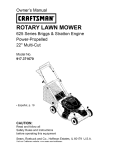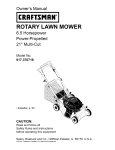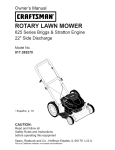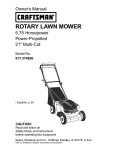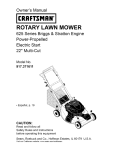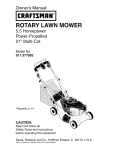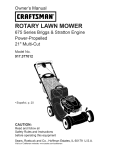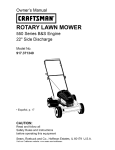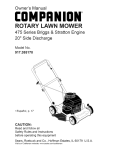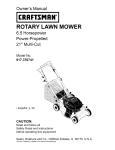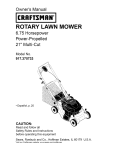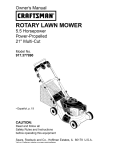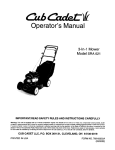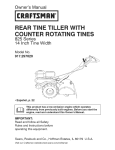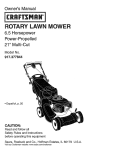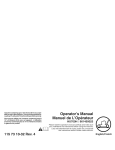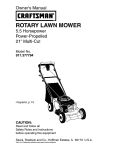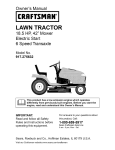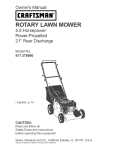Download Craftsman 917.371820 Owner`s manual
Transcript
Owner's
Manual
(RRFT$1VlRH
°
ROTARY LAWN MOWER
160cc Honda Engine
Power-Propelled
21" Multi-Cut
Model No.
917.371820
• EspaSol, p 19
CAUTION:
Read and follow all
Safety Rules and Instructions
before operating this equipment
Sears, Roebuck and Co, Hoffman Estates, IL 60179
Visit our Craftsman
website:www
sears com/craftsman
USA
Warranty ................................................
2
Safety Rules .......................................
2-4
Product Specifications
.........................
4
Assembly / Pre-Operation
.....................
6
Operation ..........................................
7-11
Maintenance
Schedule ........................
12
2-YEAR
FULL WARRANTY
Maintenance
...................................
12-15
Service and Adjustments
.....................
15
Storage ...........................................
16-17
Troubleshooting
..............................
17-18
Repair Parts ....................................
38-46
Sears Service ........................
Back Cover
ON CRAFTSMAN
LAWN
MOWER
If this Craftsman Lawn Mower fails due to manufacturer
defects in material or
workmanship
within two years from the date of purchase, return it to any Sears store,
Parts & Repair Center or other Craftsman outlet for free repair (or replacement
if repair
proves impossible).
This warranty applies for only 90 days from the date of purchase
ever used for commercial
or rental purposes.
This warranty
if this Lawn
Mower
is
does not cover:
Expendable
items that become worn during normal use, such as rotary mower
blades, blade adapters, belts, air cleaners and spark plug.
Repairs necessary because of operator abuse or negligence,
including bent
crackshafts
and the failure to assemble, operate or maintain this Lawn Mower
according to all supplied product instructions.
This warranty
applies
only while this product
This warranty gives you specific
vary from state to state.
Sears,
Roebuck
is used in the United States.
legal rights, and you may also have other rights which
and Co., Hoffman
Estates,
IL 60179
IMPORTANT:
This cutting machine is capable of amputating
hands and feet and throwing objects. Failure to observe the following safety instructions
could result in serious
injury or death.
_l, Look for this symbol to point out
important safety precautions.
It means
CAUTIONN!
BECOME ALERTH!
YOUR SAFETY IS INVOLVED.
AWARNING:
Battery posts, terminals and
related accessories
contain lead and lead
compounds,
chemicals
known to the State
of California to cause cancer and birth
A WARNING:
In order to prevent accidental starting when setting up, transporting, adjusting or making repairs,
always disconnect
spark plug wire and
place wire where it cannot come in contact with plug.
_WARNING:
Engine exhaust, some of its
constituents,
and certain vehicle components contain or emit chemicals known
to the State of California to cause cancer
defects or other reproductive
harm. Wash
hands after handling.
A CAUTION:
Muffler and other engine
parts become extremely hot during
operation and remain hot after engine has
stopped. To avoid severe burns on contact,
stay away from these areas.
and birth defects
harm.
or other reproductive
I. GENERAL
OPERATION
• Always wear safety goggles or safety
glasses with side shields when operating
mower.
• Read, understand,
and follow all
instructions
on the machine and in the
manual(s) before starting. Be thoroughly
familiar with the controls and the proper
use of the machine before starting.
• Do not put hands or feet near or under
rotating parts. Keep clear of the discharge opening at all times.
• Only allow responsible
individuals, who
are familiar with the instructions,
to operate the machine.
II. SLOPE
Slopes are a major factor related to slip &
fall accidents which can result in severe injury. All slopes require extra caution. If you
feel uneasy on a slope, do not mow it.
DO:
• Mow across the face of slopes: never
up and down. Exercise extreme caution
when changing direction on slopes.
• Remove obstacles such as rocks, tree
limbs, etc.
• Watch for holes, ruts, or bumps. Tall
grass can hide obstacles.
DO NOT:
• Clear the area of objects such as rocks,
toys, wire, bones, sticks, etc., which
could be picked up and thrown by blade.
• Be sure the area is clear of other people
before mowing. Stop machine if anyone
enters the area.
• Do not operate the mower when barefoot or wearing open sandals. Always
wear substantial
foot wear.
• Do not trim near drop-offs, ditches or
embankments.
The operator could lose
footing or balance.
• Do not trim excessively
steep slopes.
• Do not mow on wet grass. Reduced footing could cause slipping.
• Do not pull mower backwards
unless
absolutely necessary. Always look down
and behind before and while moving
backwards.
III. CHILDREN
• Never direct discharged
material toward
anyone. Avoid discharging
material
against a wall or obstruction.
Material
may richochet back toward the operator. Stop the blade when crossing gravel
surfaces.
Tragic accidents can occur if the operator
is not alert to the presence of children.
Children are often attracted to the machine
and the mowing
that children will
saw them.
• Keep children
and under the
• Do not operate the mower without
proper guards, plates, grass catcher or
other safety protective devices in place.
• See manufacturer's
instructions for
proper operation and installation of
accessories.
Only use accessories
approved by the manufacturer.
• Stop the blade(s) when crossing gravel
drives, walks, or roads.
• Stop the engine (motor) whenever you
leave the equipment,
before cleaning the
mower or unclogging the chute.
• Shut the engine (motor) off and wait until
the blade comes to complete stop before
removing grass catcher.
• Mow only in daylight or good artificial
light.
• Do not operate the machine while under
the influence of alcohol or drugs.
• Never operate machine in wet grass.
Always be sure of your footing: keep a
firm hold on the handle; walk, never run.
• Disengage the self-propelled
mechanism or drive clutch on mowers so
equipped before starting the engine.
• If the equipment
should start to vibrate
abnormally, stop the engine (motor) and
check immediately
for the cause. Vibration is generally a warning of trouble.
OPERATION
activity. Never assume
remain where you last
out of the trimming area
watchful care of another
responsible
adult.
• Be alert and turn machine
enter the area.
off if children
• Before and while walking backwards,
look behind and down for small children.
• Never allow children to operate the machine.
• Use extra care when approaching
blind
corners, shrubs, trees, or other objects
that may obscure vision.
IV. SAFE
HANDLING
OF GASOLINE
Use extreme care in handling gasoline.
Gasoline is extremely flammable and the
vapors are explosive.
• Extinguish all cigarettes, cigars, pipes
and other sources of ignition.
• Use only an approved container.
• Never remove gas cap or add fuel with
the engine running. Allow engine to cool
before refueling.
• Never refuel the machine indoors.
• Never store the machine or fuel container where there is an open flame, spark
or pilot light such as a water heater or on
other appliances.
3
• Neverfill containersinsidea vehicle, on
a truck or trailer bedwith a plasticliner.
Always place containerson the ground
awayfrom yourvehicle beforefilling.
• Removegas-poweredequipmentfrom
the truck or trailerand refuel it on the
ground. If this is not possible,then
refuelsuch equipmentwith a portable
container,ratherthan from a gasoline
dispensernozzle.
• Keepthe nozzle in contactwith the rim
of the fuel tank or containeropeningat
all times untilfueling is complete. Do
not use a nozzlelock-opendevice.
• If fuel is spilled on clothing,change
clothingimmediately.
• Neveroverfillfuel tank. Replacegas
cap and tightensecurely.
• Keepnuts and bolts, especiallyblade
attachmentbolts, tight and keepequipmentin good condition.
• Nevertamperwith safetydevices.Check
their proper operationregularly.
• Keepmachinefree of grass, leaves,or
other debris build-up.Cleanoil or fuel
spillage.Allow machineto coolbefore
storing.
• Stop and inspectthe equipmentif you
strike an object. Repair,if necessary,
beforerestarting.
• Neverattemptto makewheel height
adjustmentswhile the engine is running.
• Grasscatchercomponentsare subject
to wear, damage,anddeterioration,
which could expose movingparts or
allowobjectsto be thrown.Frequently
checkcomponentsand replacewith
manufacturer'srecommendedparts,
V. GENERAL SERVICE
when necessary.
• Neverrun a machineinsidea closed
• Mowerbladesare sharpand can cut.
area.
Wrap the blade(s)or wear gloves,and
• Nevermakeadjustmentsor repairswith
useextra cautionwhen servicingthem.
the engine (motor)running.Disconnect • Do not changethe enginegovernorsetthe spark plug wire, and keepthe wire
ting or overspeedthe engine.
awayfromthe plug to preventaccidental • Maintainor replacesafetyand instrucstarting.
tion labels,as necessary.
AWARNING:
This lawn mower is equipped with an internal combustion
engine and
should not be used on or near any unimproved
forest-covered,
brush-covered
or
grass-covered
land unless the engine's exhaust system is equipped with a spark
arrester meeting applicable local or state laws (if any). If a spark arrester is used, it
should be maintained
in effective working order by the operator.
In the state of California the above is required by law (Section 4442 of the California
Public Resources Code). Other states may have similar laws. Federal laws apply on
federal lands. A spark arrester for the muffler is available through your nearest Sears
Parts & Repair Center (See the REPAIR PARTS section of this manual).
Serial Number:
Date of Purchase:
Gasoline
Capacity
/ Type:
1.0 Quarts
(Unleaded
Oil Capacity:
18.5 Ounces
Oil Type (API SG-SL):
SAE 30 (above
Spark
Plug (Gap:
NGK BPR6ES
Valve
Clearance
.030")
(+ 0.04 mm):
Intake: 0.015
Blade Bolt Torque:
Record
32°F) or SAE 10W-30
mm;
Exhaust:
0.020 mm
35-40 ft. Ibs.
• The model and serial numbers
housing.
Regular)
will be found on a decal on the rear of the lawn mower
both serial number
and date of purchase
in space provided
above.
Repair Protection Agreements
Congratulations
on making a smart purchase. Your new Craftsman®
product is
designed and manufactured
for years of
dependable
operation.
But like all products, it may require repair from time to
time. That's when having a Repair Protection Agreement
can save you money and
aggravation.
•
Fast help by phonephone support from a Sears representative
on
products requiring in-home repair, plus
convenient
repair scheduling.
Once you purchase the Agreement,
a
simple phone call is all that it takes for you
to schedule service. You can call anytime
day or night, or schedule a service appointment online.
Sears has over 12,000 professional
repair
specialists,
who have access to over 4.5
million quality parts and accessories.
That's the kind of professionalism
you can
count on to help prolong the life of your
new purchase for years to come. Purchase
your Repair Protection Agreement
today!
Some limitations
and exclusions
apply.
For prices and additional
information
call 1-800-827-6655.
Purchase a Repair Protection Agreement
now and protect yourself from unexpected
hassle and expense.
Here's what's included in the Agreement:
•
Expert service
by our 12,000 profesional repair specialists.
•
Unlimited
service and no charge for
parts and labor on all covered repairs.
•
Product
replacement
if your covered
product can't be fixed.
•
Discount
of 10% from regular price of
service and service-related
parts not
covered by the agreement;
also, 10%
off regular price of preventive maintenance check.
Sears
Installation
Service
For Sears professional
installation
of home
appliances,
garage door openers, water
heaters, and other major home items, in
the U.S.A. call 1-800-4-MY-HOIMIE®.
These accessories
were available when this lawn mower was produced.
They are not
shipped
with your mower. They are also available at most Sears retail outlets and
service centers.
Some of these accessories
may not apply to your lawn mower.
LAWN MOWER PERFORMANCE
CLIPPING
DEFLECTORS
FOR
STABILIZER
REAR DISCHARGE
LAWN MOWERS
GRASS CATCHERS
FOR
REAR DISCHARGE
GRASS
CATCHERS
FOR
SIDE DISCHARGE
LAWN MOWERS
LAWN MOWERS
LAWN MOWER MAINTENANCE
MUFFLERS
BELTS
AIR FILTERS
BLADES
BLADE ADAPTERS
5
SPARK PLUGS
WHEELS
ENGINE OIL
Read these instructions
and this manual in its entirety before you attempt to assemble or
operate your new lawn mower.
IMPORTANT:
This lawn mower is shipped WITHOUT
OIL OR GASOLINE
in engine.
Your new lawn mower has been assembled
at the factory with the exception
of those
parts left unassembled
for shipping purposes. All parts such as nuts, washers, bolts, etc.,
necessary to complete the assembly have been placed in the parts bag. To ensure safe
and proper operation of your lawn mower, all parts and hardware you assemble must be
tightened securely. Use the correct tools as necessary to ensure proper tightness.
TO REMOVE
MOWER
FROM
CARTON
1.
Remove loose parts included with
mower,
2. Cut down two end corners of carton
and lay end panel down flat.
3. Remove all packing materials except
padding between upper and lower
handle and padding holding operator
4.
presence control bar to upper handle.
Roll lawn mower out of carton and
check carton thorougly
loose parts.
Handle
bracket
'Bolt
Knob
for additional
HOW TO SET UP YOUR MOWER
TO UNFOLD
HANDLE
IMPORTANT:
Unfold handle carefully so
as not to pinch or damage control cables.
1. Raise lower handle section to operating
position and align hole in handlewith
one
of three height positioning
holes.
2. Insert handle bolt through handle and
bracket and secure with knob.
3.
4.
Repeat for opposite side of handle.
Remove protective padding, raise upper handle section into place on lower
handle and tighten both handle knobs.
5. Remove any packing material from
around control bar.
TO ASSEMBLE
UP
CATCHER
1. Put grass catcher frame into grass bag
with rigid part of bag on the bottom.
Make sure the frame handle is outside
of the bag top.
2. Slip vinyl bindings over frame.
NOTE: If vinyl bindings are too stiff, hold
them in warm water for a few minutes. If
bag gets wet, let it dry before using.
Your lawn mower handle can be adjusted
for your mowing comfort. Refer to "ADJUST HANDLE" in the Service and Adjustments section of this manual.
Operator
l
control bar
GRASS
} >._j
Frame
handle
MOWING
POSITION
Upper
handle
Handle
knob
Lower handle
Vinyl
bindings
TO INSTALL
Frame
opening
ATTACHMENTS
Your lawn mower was shipped ready to
be used as a mulcher. To convert to bagging or discharging,
see "TO CONVERT
MOWER" in the Operation section of this
manual.
KNOW YOUR LAWN
MOWER
READ THIS OWNER'S
MANUAL AND ALL SAFETY RULES BEFORE OPERATING
YOUR LAWN MOWER.
Compare the illustrations with your lawn mower to familiarize
yourself with the location of various controls and adjustments.
Save this manual for
future reference.
These symbols may appear on your lawn mower
product.
Learn and understand
their meaning.
CAUTION
OR WARNING
ENGINE
ON
ENGINE
OFF
FAST
SLOW
or in literature
CHOKE
Operator
presence
control
FUEL
supplied
OIL
with the
DANGER, KEEP HANDS
AND FEET AWAY
Blade/brake control
•Drive control lever
Throttle/
engine
control
Handle knob
catcher
Starter handle
Gasoline filler cap
valve lever
plug
Spark
plug
Single point height adjuster handle
Engine oil cap with dipstick
Mulcher door
IMPORTANT:
MEETS
This lawn mower
CPSC
SAFETY
is shipped
WITHOUT
Muffler
OIL OR GASOLINE
in the engine.
REQUIREMENTS
Sears rotary walk-behind
power lawn mowers conform to the safety standards
American
National Standards
Institute and the U.S. Consumer Product Safety
mission.
Operator presence control bar - must
be held down to the handle to start the
blade. Release to stop the blade.
Starter handle - used for starting engine.
Throttle/engine
control
- used for starting and stopping the engine; and allows
you to select either FAST or SLOW engine
speed.
Mulcher door - allows conversion to discharging
or bagging
operation.
of the
Com-
Mulcher plug - located at the rear discharge opening.
Must be removed when
converting to bagging operation.
Single point height adjuster
- used to
adjust cutting height of lawn mower.
Drive control
lever - used to engage
power-propelled
forward motion of lawn
mower.
Blade / brake control
- used to engage
7 the blade after the engine is started.
The operationof any lawn
SAFETY
GLASSES
mowercan result in foreign
objectsthrowninto the
eyes,which can result in
severeeye damage.Always
wear safetyglassesor eye shieldswhile
operatingyour lawn moweror performing
any adjustmentsor repairs.We recommenda standardsafetyglassesor wide
vision safety maskworn over spectacles.
HOW TO USE YOUR LAWN MOWER
THROTTLE
/ ENGINE
CONTROL
The engine is controlled
by a throttle control located on the side of the upper handle.
CHOKE position is for starting a cold engine;
FAST position is for starting a warm engine,
normal cutting, trimming
and better grass
bagging; SLOW position is for light cutting,
trimming and fuel economy, STOP position
is for stopping the engine.
CHOKE
I",1
_
FAST
,,
_
SLOW
"v"Ill
.
/
,,_"
I I
STOP
I I/
,1111
_--
\
II
Operator presence control bar Blade / brake
control lever
TO
ENGAGE
BLADE
DRIVE
CONTROL
• Self-propelling
is controlled
by holding the operator presence control bar
down to the handle and pulling the drive
control lever rearward to the handle.
The farther toward the handle the lever
is pulled, the faster the unit will travel.
• Forward motion will stop when either
the operator presence control bar or
drive control lever are released. To stop
forward motion without stopping blade,
release the drive control lever only. Hold
operator presence control bar down
against handle to continue mowing
without self-propelling
NOTE: If after releasing the drive control
the mower will not roll backwards,
push
the mower forward slightly to disengage
drive wheels.
• To keep drive control
turning corners, push
handle to lift the front
ground while turning
engaged when
down on the
wheels off the
lawn mower.
3resence control bar
BLADE CONTROL
ACAUTION:
When
the blade control
is
engaged, the blade turns.
• To start the blade, hold the operator
presence control bar down to the handle
and push the blade/brake
control lever
forward until it latches.
To stop the
blade, release the operator presence
control bar. Do not pull the blade/brake
lever rearward with the operator presence control bar down against the
handle. Allow a cold engine to warm
up in high idle position for one minute
before engaging the blade.
NOTE: It is normal to hear the belt slip as the
blade is engaged and comes up to speed.
• Do not start the blade in uncut grass.
Move the mower out of uncut grass
before starting the blade.
_CAUTION:
Federal regulations
require
this blade/brake
control to minimize the
risk of blade contact injury. Do not under
any circumstances
attempt to defeat the
function of this control.
Adjustment
turnbuckle
DRIVE
TO
ENGAGE
DRIVE
CONTROL
CONTROL
Drive
control
lever
DRIVE
CONTROL
DISENGAGED
ADJUSTMENT
Over time, the drive control system may
become "loose", resulting in decreased
speed. There is a turnbuckle on the drive
control housing to increase tension on the
drive cable. Proceed as follows:
1. Turn unit off and disconnect
spark plug
wire from spark plug.
2. Rotate turnbuckle on drive control to
increase drive speed.
3. Operate mower to test drive speed.
Readjust as required.
4. If condition fails to improve after the
above steps (forward speed remains the
same), your drive belt is worn and should
be replaced.
TO ADJUST
CUTTING
HEIGHT
Grass
catcher
frame
All four wheels are adjusted by a single lever.
• Pull adjuster lever toward wheel. To
raise mower, move lever forward to
desired position. To lower mower, move
the lever toward the rear.
LEVER
BACKWARD
TO LOWER
MOWER
\
\
Height adjuster
lever
TO CONVERT
MOWER
Your lawn mower was shipped ready to be
used as a mulcher.
To convert to bagging
or discharging:
REAR
BAGGING
• Open rear door, remove mulcher plug.
Store mulcher plug in a safe place.
• You can now install the grass catcher.
• To convert to mulching or discharging
operation,
install mulcher plug into rear
discharge opening of mower.
LEVER
FORWARD
TO RAISE
MOWER
TO ATTACH GRASS CATCHER
1. Lift the rear door of the lawn mower
and place the grass catcher frame side
hooks onto the door pivot pins.
2. The grass catcher is secured to the lawn
mower housing when the rear door is
lowered onto the grass catcher frame.
• I,CAUTION:
Do not run your lawn mower
without mulcher plug or approved grass
catcher in place. Never attempt to operate the lawn mower with the rear door
removed
or propped
Pivot
"
open.
Rear
Grass
catcher
handle
Mulcher plug
SIDE DISCHARGING
• Mulcher plug must be installed into rear
discharge opening of mower.
• Open mulcher door and install discharge deflector under door as shown.
• Mower is now ready for discharging
operation.
• To convert to mulching or bagging
operation, discharge deflector must
be removed and mulcher door closed.
Catcher frame hook
TO EMPTY
1.
2.
GRASS
CATCHER
Lift up on grass catcher using the
frame handle.
Remove grass catcher with clippings
from under lawn mower handle.
3. Empty clippings from bag.
NOTE: Do not drag the bag when emptying; it will cause unnecessary
wear.
Open mulcher door
Install
discharge
9 deflector
• Change the oil after every 25 hours of
operation or each season. You may
need to change the oil more often
under dusty, dirty conditions.
See "TO
CHANGE ENGINE OIL" in the Maintenance section of this manual.
ADD GASOLINE
• Fill fuel tank to bottom of tank filler neck.
Do not overfill.
Use fresh, clean, regular
unleaded gasoline with a minimum of
87 octane. Do not mix oil with gasoline.
Purchase fuel in quantities that can be
used
within 30 days to assure fuel freshMOWERISNOWREADYFOR
ness.
DISCHARGING
OPERATION
_iL CAUTION:
Wipe off any spilled oil or
fuel. Do not store, spill or use gasoline
SIMPLE STEPS TO REMEMBER
WHEN
near an open flame.
CONVERTING
YOUR LAWN MOWER
A CAUTION:
Alcohol blended fuels
FOR MULCHING
1.
2.
(called gasohol or using ethanol or methanol) can attract moisture which leads to
separation
and formation of acids during
storage. Acidic gas can damage the fuel
system of an engine while in storage.
To
avoid engine problems, the fuel system
should be emptied before storage of 30
days or longer. Empty the gas tank, start
the engine and let it run until the fuel lines
and carburetor are empty. Use fresh fuel
next season.
See Storage Instructions
for
additional information.
Never use engine
or carburetor
cleaner products in the fuel
tank or permanent damage may occur.
-
Rear mulcher plug installed.
Mulcher door closed.
FOR REAR BAGGING
-
1. Rear mulcher plug removed.
2. Grass catcher installed.
3. Mulcher door closed.
FOR SIDE DISCHARGING
1.
2.
-
Rear mulcher plug installed.
Discharge deflector installed.
_CAUTION:
Do not run your lawn
mower without mulcher plug or approved
grass catcher in place. Never attempt to
operate the lawn mower with the rear door
removed or propped open.
BEFORE
ADD
STARTING
Oil fill cap /
di
Gasoline
filler cap
ENGINE
OIL
Your lawnmower
is shipped without oil in
the engine. For type and grade of oil to
use, see "ENGINE" in the Maintenance
section of this manual.
A CAUTION:
DO NOT overfill engine with
oil, or it will smoke heavily from the muffler
on startup.
1. Be sure lawnmower
is level.
2. Remove oil dipstick from oil fill spout.
3. You receive a container of oil with the
Upper
mark
Lowel
mark
TO STOP
unit. Slowly pour the entire container
down the oil fill spout into the engine.
4. Insert and tighten dipstick.
IMPORTANT:
• Check oil level before each use. Add oil
if needed.
Fill to full line on dipstick.
ENGINE
• To stop engine, move throttle control
lever to STOP position. Wait until blade
and all moving parts have stopped and
turn fuel valve to OFF position if you do
not intend to restart the engine soon.
10
TO START
ENGINE
with water and let dry before using.
Keep top of engine around starter clear
and clean of grass clippings and chaff.
This will help engine air flow and extend
engine life.
NOTE: Due to protective coatings on the
engine, a small amount of smoke may be
present during the initial use of the product and should be considered
normal.
1. Be sure fuel valve is in the ON position.
2. To start a cold engine, move handle
mounted throttle/choke
control lever to
MULCHING
CHOKE position.
Pull starter handle quickly. Do not allow
starter rope to snap back.
4. Slowly move throttle control lever to
FAST position after engine starts.
• To start a warm engine, move throttle
control lever to FAST position, then follow steps above.
NOTE: Allow a cold engine to warm up for
one minute before starting the blade. See
"BLADE CONTROL"
in this section of this
manual.
• The special mulching blade will recut
the grass clippings many times and
reduce them in size so that as they fall
onto the lawn they will disperse into
the grass and not be noticed. Also, the
mulched grass will biodegrade
quickly
to provide nutrients for the lawn. Always
mulch with your highest engine (blade)
speed as this will provide the best recutting action of the blades.
• Avoid cutting your lawn when it is wet.
Wet grass tends to form clumps and
interferes with the mulching action. The
best time to mow your lawn is the early
afternoon.
At this time the grass has
dried, yet the newly cut area will not be
exposed to direct sunlight.
• For best results, adjust the lawn mower
cutting height so that the lawn mower
cuts off only the top one-third of the
grass blades.
If the lawn is overgrown
it
will be necessary to raise the height of
cut to reduce pushing effort and to keep
from overloading
the engine and leaving
clumps of mulched grass. For extremely
heavy grass, reduce your width of cut
by overlapping
previously cut path and
mow slowly.
ON
Fuel valve lever
CAUTION:
TIPS
Do not use de-thatcher
blade attachments
on your mower. Such
attachments
are hazardous, will damage
your mower and could void your warranty.
1/3
• Under certain conditions, such as very
tall grass, it may be necessary to raise
the height of cut to reduce pushing
effort and to keep from overloading
the
engine and leaving clumps of grass
clippings. It may also be necessary to
reduce ground speed and/or run the
mower over the area a second time.
• For extremely heavy cutting, reduce the
width of cut by overlapping
previously
cut path and mow slowly.
• For better grass bagging and most cutting conditions,
the engine speed should
be set in the FAST position.
• Pores in cloth grass catchers can become filled with dirt and dust with use
and catchers will collect less grass.
prevent this, regularly hose catcher
To
off
TIPS
IMPORTANT:
For best performance,
keep mower housing free of built-up
grass and trash. See "CLEANING"
in the
Maintenance
section of this manual.
3.
MOWING
MOWING
11
• Certain types of grass and grass
conditions may require that an area be
mulched a second time to completely
hide the clippings.
When doing a second cut, mow across (perpendicular)
to
the first cut path.
• Change your cutting pattern from week
to week. Mow north to south one week
then change to east to west the next
week. This will help prevent matting and
graining of the lawn.
BEFORE
EACH
USE
SCHEDULE
Check
I
EVERY
10
HOURS
EVERY
25HOURS
OR SEASON
EVERY
100
HOURS
BEFORE
STORAGE
for Loose Fasteners
Clean / Inspect Grass
_
AFTER
EACH
USE
Check
Catcher*
Tires
N Check Drive Wheels ***
Clean Lawn Mower ....
M
Clean
under Drive Cover
O
Check
Drive Belt / Pulleys
_
Check
/ Sharpen
R
Lubrication
Clean and Recharge
Check
v'
v'
***
v'
v'3
***
/ Replace
Blade
Battery
**
vl
Engine Oil level
Change Engine Oil
N Clean Air Filter
v'
_
Inspect
Muffler
N
Replace
Spark
Replace
Air Filter Paper Cartridge
v'
Plug
v'
Empty fuel system or add Stabilizer
* (if so equipped)
** Electric-Start mowers
*** Power-Propelled
mowers
**** Use a scraper
to clean under deck
GENERAL
1
2
3
4
5
-
Change more often if operating under a heavy load or in high outdoor temperatures.
Service more often if operating in dirty or dusty conditions.
Replace blades more often when mowing in sandy soil.
Charge 48 hours at end of season.
And after each 5 hours of use.
LUBRICATION
RECOMMENDATIONS
CHART
The warranty on this lawn mower does not
cover items that have been subjected to
operator abuse or negligence.
To receive
full value from the warranty, operator must
maintain unit as instructed in this manual.
Wheel
adjuster (on
each wheel)
Some adjustments
will need to be made
periodically
to properly maintain your unit.
Engine oil
Mulcher
At least once a season, check to see if
you should make any of the adjustments
described
in the Service and Adjustments
section of this manual.
door hinge pin
Rear door
• At least once a year, replace the spark
plug, clean or replace air filter element
and check blade for wear. A new spark
plug and clean/new air filter element
assure proper air-fuel mixture and help
your engine run better and last longer.
• Follow the maintenance
schedule in this
manual.
BEFORE
EACH
USE
• Check engine oil level.
• Check for loose fasteners.
LU BRICATION
Keep unit well lubricated
(See "LUBRICATION
CHART").
hinge
Handle bracket mounting pins
_ Spray lubricant
See "ENGINE" in Maintenance section.
IMPORTANT:
Do not oil or grease plastic
wheel
bearings.
Viscous
lubricants
will
attract dust and dirt that will shorten the life of
the self-lubricating
must be lubricated,
1 2graphite
bearings. If you feel they
use only a dry, powdered
type lubricant
sparingly.
LAWN MOWER
To checkblade balance,drive a nail into
a beamor wall. Leave aboutone inchof
Alwaysobservesafety ruleswhen perthe straightnail exposed. Placecenter
formingany maintenance.
holeof blade over the head of the nail.
TIRES
If blade is balanced,it should remainin
• Keep tires free of gasoline,oil, or insect
controlchemicalswhichcan harmrubber.
a horizontalposition.If eitherend of the
blademovesdownward,sharpenthe
• Avoid stumps,stones, deep ruts, sharp
heavyend untilthe blade is balanced.
objectsand other hazardsthat may
causetire damage.
Blade
DRIVEWHEELS
Checkreardrive wheelseach time you
mowto be sure they movefreely. The
wheels not turningfreely meanstrash,
grass cuttings,etc., may be insidethe
drive wheel anddust cover areaand must
be cleanedout to free drive wheels.
BLADE CARE
Forbest results,mowerblademustbe kept Blade
sharp. Replacea bent or damagedblade. bolts
A CAUTION: Useonly a replacement
bladeapprovedby the manufacturerof
Trailing
your mower.Usinga bladenot approved
edge
by the manufacturerof your moweris
hazardous,could damageyour mowerand GRASS CATCHER
void your warranty.
• The grass catcher may be hosed with
TO REMOVEBLADE
water, but must be dry when used.
1. Disconnectspark plug wire fromspark
• Check your grass catcher often for damplug and placewire where it cannot
age or deterioration.
Through normal
come in contactwith plug.
use it will wear. If catcher needs replac2. Turn lawn moweron its side. Make
ing, replace only with approved replacesure air filter andcarburetorare up.
ment catcher shown in the Repair Parts
3. Use a wood blockbetweenblade and
section of this manual.
Give the lawn
mowerhousingto preventbladefrom
mower model number when ordering.
turningwhen removingbladebolts.
GEAR CASE
NOTE: Protectyour handswith gloves
• To keep your drive system working
and/orwrap bladewith heavycloth.
properly, the gear case and area around
4. Removeblade bolts by turning counterthe drive should be kept clean and free
clockwise.
of trash build-up.
Clean under the drive
TO REPLACEBLADE
cover twice a season.
1. Positiontheblade.Besuretrailingedgeof • The gear case is filled with lubricant to the
blade(oppositesharpedge)is uptoward
proper level at the factory. The only time
the lubricant needs attention is if service
the engineand install the bladebolts.
2. Use blockof wood betweenblade and
has been performed on the gear case.
lawn mowerhousingand tightenthe
• If lubricant is required, use only Texaco
blade bolts,turning clockwise.
Starplex Premium 1 Grease, Part No.
750369. Do not substitute.
• The recommendedtighteningtorque is
36-44ft. Ibs.
ENGINE
IMPORTANT: Bladebolts are heattreatLU BRICATION
ed. If bolts need replacing,replaceonly
Use only high quality detergent oil rated with
with approvedboltsshown in the Repair
API service classification
SG-SL. Select the
Partssectionof this manual.
TO SHARPENBLADE
oil's SAE viscosity grade according to your
NOTE: Wedo not recommendsharpening expected operating temperature.
the blade- but if youdo, be surethe bladeis
SAE VISCOSITY
GRADES
balanced. An unbalancedbladewill cause
I,
eventualdamageto moweror engine.
II,
• The blade can be sharpenedwith a file
or on a grindingwheel. Do not attempt
to sharpenwhile on the mower.
13
lll'_Tj
°F
°C
-20
"30
0
-20
TEMPERATURE
30
"10
RANGE
32
0
ANTICIPATED
40
,_[
60
t0
BEFORE
80
20
NEXT
100
30
OIL
CHANGE
40
NOTE: Multi-viscosity
oils (5W30, 10W30
etc.) improve starting in cold weather, and
you should check your engine oil level frequently to avoid possible engine damage
from running low on oil.
Change the oil after every 25 hours of operation or at least once a year if the lawn mower
is not used for 25 hours in one year.
Check the crankcase oil level before
7.
Continue adding small amounts of
oil and rechecking the dipstick until it
reads full. DO NOT overfill, or engine
will smoke on startup.
8. Always be sure to retighten oil fill cap/
dipstick before starting engine.
9. Reconnect
spark plug wire to plug.
AIR FILTER
Your engine will not run properly and may
be damaged by using a dirty air filter.
Replace the air filter every 100 hours of
operation or every season, whichever occurs first. Service air cleaner more often
starting the engine and after each five (5)
hours of continuous
use. Tighten oil plug
securely each time you check the oil level.
TO CHANGE
ENGINE
OIL
under dusty conditions.
NOTE: Before tipping lawn mower to drain
oil, empty fuel tank by running engine until
fuel tank is empty.
1. Disconnect spark plug wire from spark
plug and place wire where it cannot
come in contact with plug.
2. Remove oil fill cap/dipstick;
lay aside
on a clean surface.
3. Tip lawn mower on its side as shown
and drain oil into a suitable container.
Rock lawn mower back and forth to remove any oil trapped
TO CLEAN AIR FILTER
1. Remove cover.
2. Carefully remove cartridge.
3. Clean by gently tapping on a flat surface. If very dirty, replace cartridge.
ACAUTION:
Petroleum solvents, such as
kerosene, are not to be used to clean cartridge. They may cause deterioration
of the
cartridge. Do not oil cartridge. Do not use
pressurized
air to clean or dry cartridge.
4. Install cartridge, then replace cover.
inside of engine.
Tab
Cartridge
Wipe off any spilled oil from lawn
mower or side of engine.
5. Fill engine with oil. Slowly pour oil
down the oil fill spout into the engine.
6. Wait one minute to allow oil to settle.
,
Filter cove1
MUFFLER
Use guage on oil fill cap/dipstick
for
checking level. Insert dipstick into the
tube and rest the oil fill cap on the tube.
DO NOT thread the cap into the tube
when taking reading.
Inspect and replace corroded muffler as it
could create a fire hazard and/or damage.
SPARK PLUG
Replace spark plug at the beginning of
each mowing season or after every 100
hours of operation, whichever occurs
first. Spark plug type and gap setting
are shown in the "PRODUCT
SPECIFICATIONS" section of this manual.
Oil fill cap /
dipstick
CLEANING
Upper _
mark-_
Lower"
mark
IMPORTANT:
For best performance,
keep
mower housing free of built-up grass and
trash. Clean the underside of your mower
after each use.
_
14
_CAUTION: Disconnectspark plug wire
from spark plug and place wirewhere it
cannotcomein contactwith plug.
• Cleanthe undersideof your lawn mower
by scrapingto removebuild-upof grass
and trash.
• Cleanengineoften to keeptrash from
accumulating.A cloggedengineruns
hotter andshortensenginelife.
• Keepfinishedsurfacesandwheelsfree
of all gasoline,oil, etc.
• We do not recommendusing a garden
hoseto clean lawn mowerunlessthe
electricalsystem,muffler,air filter and
carburetorare coveredto keepwater
out. Water in enginecan result in shortened enginelife.
CLEAN UNDER DRIVECOVER
Clean underdrive cover at least twice a
season.Scrapeundersideof coverwith
putty knifeor similar tool to removeany
build-upof trash or grasson undersideof
drive cover.
AWARNING: Toavoid serious injury,beforeperformingany serviceor adjustments:
1. Releasecontrolbar and stop engine.
2. Makesure the blade andall movingparts have completelystopped.
3. Disconnectspark plug wire fromspark plug and placewire where it cannotcome in
contactwith plug.
2. Whileholdinghandleassembly,remove
LAWN MOWER
knob and carriage bolt from opposite side,
TO ADJUST CUTTINGHEIGHT
align hole in handle with desired hole in
handle bracket and reassemble bolt and
See "TOADJUST CUTTINGHEIGHT"in
knob and tighten securely.
the Operationsectionof this manual.
3.
Align
opposite side of handle with
REAR DEFLECTOR
same
positioning
hole and secure with
Thereardeflector,attachedbetweenthe rear
bolt and knob.
wheelsofyourmower,is providedtominimize
the possibilitythatobjectswill be thrownout ENGINE
of the rear of the mower intothe operator's Maintenance, repair, or replacement of the
mowing position. If the deflector becomes emission control devices and systems, which
damaged,it should be replaced.
are being done at the customers
expense,
DRIVEBELT
may be performed
by any non-road engine
If yourmowerdoesnot operateproperlydue repair establishment or individual. Warranty
to suspecteddrivebelt problems,take your repairs must be performed by an authorized
mowerto a Searsor otherqualifiedservice engine manufacturer's service outlet.
centerfor repair and/oradjustment.
ENGINE SPEED
TO ADJUST HANDLE
Your engine speed has been factory set. Do
The handleon your lawn mowerhas three not attempt to increase engine speed or it
(3) height positions- adjustto heightthat
may result in personal injury. If you believe
suits you.
that the engine is running too fast or too
1. Removeknoband carriagebolt on one slow, take your lawn mower to a Sears or
side of the lower handle.
other qualified service center for repair and
Med....
adjustment.
CARBURETOR
/
Knob
15
Your carburetor
is not adjustable.
If your
engine does not operate properly due to suspected carburetor problems, take your lawn
mower to a Sears or other qualified service
center for repair and/or adjustment.
IMPORTANT:
Never tamperwith
the engine
governor, which is factory set for proper engine speed. Overspeeding
the engine above
the factory high speed setting can be dangerous. If you think the engine-governed
high
speed needs adjusting, contact a Sears or
other qualified
service center, which has
proper equipment
and experience
to make
any necessary adjustments.
Immediatelyprepareyour lawn mowerfor
storageat the end of the seasonor if the
unit will not be usedfor 30 days or more.
LAWN
Handle
bracket
Knob
ENGINE
Maintenance,
repair, or replacement
of the
emission control devices and systems, which
are being done at the customers expense,
may be performed
by any non-road engine
repair establishment
or individual. Warranty
repairs must be performed by an authorized
engine manufacturer's
service outlet.
You can fold your mower handle for storage.
1. Loosen the two (2) handle knobs on
sides of the upper handle and allow
handle to fold down to the rear.
3.
Bolt
MOWER
When lawn mower is to be stored for a period
of time, clean it thoroughly,
remove all dirt,
grease, leaves, etc. Store in a clean, dry area.
1. Clean entire lawn mower (See
"CLEANING"
in the Maintenance
section of this manual).
2. Lubricate as shown in the Maintenance
section of this manual.
3. Be sure that all nuts, bolts, screws,
and pins are securely fastened.
Inspect
moving parts for damage, breakage
and wear. Replace if necessary.
4. Touch up all rusted or chipped paint
surfaces
sand lightly before painting.
HANDLE
2.
..__
J
Remove the two (2) handle knobs and
carriage bolts on sides of the lower
handle and pivot entire handle assembly forward and allow it to rest on
mower.
Reinstall knobs and carriage bolts to
lower handle or handle brackets for
FUEL SYSTEM
IMPORTANT:
It is important to prevent gum
deposits from forming in essential fuel system
parts such as carburetor, fuel filter, fuel hose,
or tank during storage. Alcohol blended fuels
(called gasohol or using ethanol or methanol)
can attract moisture which leads to separation and formation of acids during storage.
Acidic gas can damage the fuel system of
an engine while in storage.
• Empty the fuel tank by starting the engine and letting it run until the fuel lines
and carburetor are empty.
• Never use engine or carburetor cleaner
products in the fuel tank or permanent
damage may occur.
• Use fresh fuel next season.
safe keeping.
• When setting up your handle from the
storage position, the lower handle will
require manually locking into the mowing position.
IMPORTANT:
When folding the handle for
storage or transportation,
be sure to fold
the handle as shown or you may damage
the control cables.
Operator
f
control bar
FOLD
FORWARD"
FOR
STORAGE
MOWING
POSITION
NOTE:
Fuel stabilizer is an acceptable
alternative in minimizing
the formation of fuel
gum deposits during storage. Add stabilizer
to gasoline in fuel tank or storage container.
Always follow the mix ratio found on stabilizer
container. Run engine at least 10 minutes
after adding stabilizer to allow the stabilizer
to reach the carburetor. Do not empty the gas
tank and carburetor if using fuel stabilizer.
Upper
handle
Handle
knob
Lower handle
ENGINE
16
OIL
Drain oil (with engine warm) and replace
with clean engine oil. (See "ENGINE" in
the Maintenance
section of this manual).
CYLINDER
1. Removespark plug.
2. Pourone ounce (29 ml) of oil through
spark plug hole intocylinder.
3. Pullstarter handleslowly a few times
to distributeoil.
4. Replacewith new spark plug.
OTHER
• Do not store gasolinefrom one season
to another.
• Replaceyour gasoline can if your can
starts to rust. Rustand/ordirt in your
gasolinewill causeproblems.
TROUBLESHOOTING
to a Sears
Parts
&
A CAUTION:
section in manual unless directed
CAUSE
CORRECTION
1. Dirty air filter.
2. Out of fuel.
3. Stale fuel.
,
Water
1. Clean/replace
2. Fill fuel tank.
in fuel.
5. Spark plug wire is
disconnected.
6. Bad spark plug.
7. Loose blade or broken
blade adapter.
8. Control bar in released
position.
9. Control bar defective.
10. Fuel valve lever (if so
equipped)
in OFF position.
11. Weak battery (if equipped).
12. Disconnected
battery
connector (if equipped).
13. Engine control lever is
in STOP position.
Loss
of power
Poor cut uneven
Never store the lawn mower
with gasoline in the tank inside a building
where fumes may reach an open flame or
spark. Allow the engine to cool before storing in any enclosure.
- See appropriate
Repair Center.
PROBLEM
Does not start
• If possible,store your unit indoorsand
cover it to protect it from dust anddirt.
• Coveryour unit with a suitableprotective
coverthat does not retain moisture.Do
not use plastic.Plasticcannotbreathe,
which allows condensationto form and
will causeyour unit to rust.
IMPORTANT:Nevercover mowerwhile
engineand exhaustareasare still warm.
Rear of lawn mower
housing or cutting blade
dragging in heavy grass.
2. Cutting too much grass.
3. Dirty air filter.
4. Buildup of grass, leaves,
and trash under mower.
5. Too much oil in engine.
6. Walking speed too fast.
1.
1. Worn,
bent or loose blade.
2
Wheel
heights
3
Buildup of grass, leaves
and trash under mower.
uneven.
17
air filter.
3. Empty fuel tank
with fresh, clean
4. Empty fuel tank
with fresh, clean
5. Connect wire to
and refill tank
gasoline.
and refill tank
gasoline.
plug.
6. Replace spark plug.
7. Tighten blade bolt or
replace blade adapter.
8. Depress control bar to
handle.
9. Replace control bar.
10.Turn fuel valve lever
to the ON position.
11. Charge battery.
12. Connect battery to engine.
13. Place engine control
in FAST position.
1. Raise cutting
lever
height.
2. Raise cutting height.
3. Clean/replace
air filter.
4. Clean underside of mower
housing.
5. Check oil level.
6. Cut at slower walking speed.
1. Replace blade. Tighten
blade bolt.
2. Set all wheels at same
height.
3. Clean underside
mower housing.
of
TROUBLESHOOTING
- See appropriate
to a Sears Parts & Repair Center,
PROBLEM
Excessive
vibration
Starter rope
hard to pull
Grass
catcher
not filling
(If so equipped)
Hard to push
section in manual unless directed
CAUSE
1. Worn,
CORRECTION
bent or loose blade.
1.
2.
2.
Bent engine
1.
Engine flywheel brake is on
when control bar is released.
1.
2.
Bent engine
2.
3.
4.
Blade adapter broken.
Blade dragging in grass.
5.
Defective
1.
2.
Cutting height too low.
Lift on blade worn off.
3.
Catcher
1.
Grass is too high or wheel
height is too low.
Rear of lawn mower
2.
crankshaft.
crankshaft.
blade/brake
not venting
clutch.
housing or cutting blade
dragging in grass.
3. Grass catcher too full.
4.
Handle height position
right for you.
Blade/brake
clutch does
not engage
1.
Defective
not
Engine dies
when starting
blade
1.
Cold engine.
2.
Mower
Loss of drive
1.
Belt wear.
or slowing of
drive speed
2.
3.
Belt off of pulley.
Drive cable worn or broken.
4.
"Loose"
blade control.
is in uncut grass.
18
Depress control bar to
upper handle before
pulling starter rope.
Contact a Sears or other
qualified service center.
Replace blade adapter.
Move lawn mower to cut
grass or to hard surface.
5. Replace blade/brake
clutch.
3.
4.
1. Raise cutting height.
2. Replace blade.
3. Clean grass catcher.
air.
drive control
Replace blade. Tighten
blade bolt.
Contact a Sears or other
qualified service center.
system.
1.
Raise cutting
height.
2.
Raise rear of lawn mower
housing one (1) setting
higher.
3. Empty grass catcher.
4. Adjust handle height to suit.
1.
Replace
blade/brake
control.
1. Allow engine to warm up
for one minute.
2. Move mower to cleared area.
1. Check/replace
2. Check/reinstall
drive belt.
drive belt.
3. Replace drive cable.
4. Adjust drive control.
Garantia .........................................................
19
Reglas de Seguridad ................................ 19-21
Especificaciones del Producto ....................... 21
Montaje / Pre-Operacion ............................... 23
Operacion .................................................
24-28
Mantenimiento .......................................... 29-31
GARANTiA
TOTAL
DE LA CORTADORA
Programa de Mantenimiento ......................... 29
Servicio y Adjustes ........................................ 32
AImacenamiento ....................................... 33-34
Identificacion de problemas ...................... 34-35
Servicio Sears .......................................... 36-46
Orden de Partes ............................... Contratapa
DE CleSPED
CRAFTSMAN
POR 2 ANOS
Si esta Segadora Craftsman Ilega a presentar algOn desperfecto por defectos de materiales
o fabricacion durante un plazo de dos afios a partir de la fecha de compra, Ilevela de vuelta a
cualquiera de las tiendas Sears, al Centro de Repuestos y Reparacion, o a otro comercio donde se
vendan los equipos Craftsman, a efectos de que se la reparen sin costo (o bien se la reemplacen,
en caso que no sea posible repararla).
Siesta Segadora Ilega a ser utilizada con fines comerciales o arrendada, la presente garantia tendra
vigencia por s61o 90 dias a partir de la fecha de compra.
La presente garantia no cubre:
• Aquellas piezas fungibles que se desgastan por el uso normal, tales como las cuchillas rotatorias
de la cortadora, los adaptadores de las cuchillas, las correas, los filtros de aire y las bujias.
• Aquellas reparaciones que haya que hacer debido a mal uso o negligencia por parte del operador,
incluidos el arbol del cigQefial torcido u omisiones relativas al armado, manejo o mantenimieno de
la Segadora en un todo de acuerdo a las instrucciones provistas con el equipo.
La presente garantia se aplicara solamente en tanto el articulo sea usado en los Estados Unidos.
Esta garantia le otorga a usted derechos legales especificos; puede que usted tenga, ademas, otros
derechos, los cuales varian de estado a estado.
Sears, Roebuck and Co., Hoffman Estates, IL 60179
IMPORTANTE: Esta maquina cortadaora es capaz de amputar las manos y los manos y los pies y
de lanzar objetos. Si no se observan las instrucciones de seguridad siguientes se pueden producir
lesiones graves o la muerte.
,_IBusque este simbolo que sefiala las precauciones de seguridad de importancia. Quiere
decir- iiiATENClON!!! iiiESTE ALERTO!!!
SU SEGURtDAD ESTA COMPROMETIDA.
AI:_,PRECAUCl6N" El tubo de escape del motor,
algunos de sus constituyentes y algunos componentes del vehiculo contienen o desprenden
productos quimicos conocidos en el Estado de
California como causa de cancer y defectos al
nacimiento u otros dafios reproductivos.
dI_ADVERTENCIA: Siempre desconecte el
alambre de la bujia y p6ngalo donde no pueda
entrar en contacto con la bujia, para evitar el
arranque por accidente, durante la preparacion,
el transporte, el ajuste o cuando se hacen
reparaciones.
_PRECAUCl6N:
El silenciador y otras
piezas del motor Ilegan a sre extremadamente
calientes durante la operacion y siguen siendo
calientes despues de que el motor haya parado.
Para evitar quemaduras severas, permanezca
lejos de estas areas.
_ADVERTENClA:
Los bornes, terminales y
accesorios relativos de la bateria contienen
plomo o compuestos de plomo, productos
quimicos conocidos en el Estado de California
como causa de cancer y defectos al nacimiento
u otros dafios reproductivos. Lavar las manos
despues de manipularlos.
19
I. OPERACION
• Antes de empezar, debe familiarizarse
completamente con los controles y el uso
correcto de la maquina. Para esto, debe leer
y comprender todas las instrucciones que
aparecen en la maquina yen los manuales
de operacion.
• No ponga las manos o los pies cerca o
debajo de las partes rotatorias. Mantengase
siempre lejos de la abertura de la descarga.
• Permita que solamente las personas responsables que esten familiarizadas con las
instrucciones operen la maquina.
• Despeje el area de objetos tales como piedras, juguetes, alambres, huesos, palos, etc.
que pueden ser recogidos y lanzados por las
cuchillas.
• AsegQrese que el area no se hallen personas, antes de segar. Pare la maquina si
alguien entra en el area.
• No opere la maquina sin zapatos o con
sandalias abiertas. P6ngase siempre zapatos
s61idos.
• No tire de la segadora hacia atras a menos
que sea absolutamente necesario. Mire
siempre hacia abajo y hacia detras antes y
mientras que se mueve hacia atras.
• Nunca dirigir el material descargado hacia
las personas. Evitar descargar material
contra paredes o barreras. El material puede
retornar al operador. Para la cuchilla cuando
se pasa por superficies de grava.
• No opere la segadora sin los respectivos
resguardos, las placas, el recogedor de
cesped u otros aditamentos dise ados para
su proteccion y seguridad.
• Refi@ase alas instrucciones del fabricante
para el funcionamiento e instalacion de
accesorios. Use Qnicamente accesorios
aprobados por el fabricante.
• Detenga la cuchilla o las cuchillas cuando
cruce por calzadas, calles o caminos de
grava.
• Parar el motor cada vez que se abandona el
aparato, antes de limpiar la segadora o de
remover residuos del tubo.
• Apagar el motor y esperar hasta que las
cuchillas esten completamente paradas
antes de remover el receptor de hierba.
• Segar solamente con luz del dia o con una
buena luz artificial.
• No opere la maquina bajo la influencia del
alcohol o de las drogas.
• Nunca opere la maquina cuando la hierba
este mojada. AsegQrese siempre de tener
buena traccion en sus pies; mantenga el
mango firmemente y camine; nunca corra.
• Desconectar el mecanismo de propulsi6n
aut6noma o el embrague de transmision en
las segadoras que Io tienen antes de poner
en marcha el motor.
• Si el equipo empezara a vibrar de una
manera anormal, pare el motor y revise de
inmediato para averiguar la causa. Generalmente la vibracion suele indicar que existe
alguna averia.
• Siempre use gafas de seguridad o anteojos
con proteccion lateral cuando opere la segadora.
II. OPERACION
SOBRE LAS CUESTAS
Los accidentes ocurren con mas frecuencia en
las cuestas. Estos accidentes ocurren debido a
resbaladas o caidas, las cuales pueden resultar
en graves lesiones. Operar la recortadora en
cuestas requiere mayor concentraci6n. Si se
siente inseguro en una cuesta, no la recorte.
HACER:
• Puede recortar a traves de la superficie de
la cuesta, nunca hacia arriba y hacia abajo.
Proceda con extrema precaucion cuando
cambie de direccion en las cuestas.
• Renueva todos los objetos extra5os, tales
como guijarros, ramas, etc.
• Debe prestar atencion a hoyos, baches o
protuberancias. Recuerde que la hierba alta
puede esconder obstaculos.
NO HACER:
• No recorte cerca de pendientes, zanjas o
terraplenes. El operador puede perder la
traccion en los pies o el equilibrio.
• No recorte cuestas demasiado inclinadas.
• No recorte en hierba mojada. La reduccion
en la traccion de la pisada puede causar
resbalones.
III. NINOS
Se pueden producir accidentes tragicos si el
operador no presta atenci6n a la presencia
de los niSos. A menudo, los niSos se sienten
atraidos por la maquina y por la actividad de
la siega. Nunca suponga que los ni5os van a
permanecer en el mismo lugar donde los vio
por Qltima vez.
• Mantenga a los ni5os alejados del area de
la siega y bajo el cuidado estricto de otra
persona adulta responsable.
• Este alerta y apague la maquina si hay niSos
que entran al area.
• Antes y cuando este retrocediendo, mire
hacia atras y hacia abajo para verificar si hay
ni5os peque5os.
• Nunca permita que los ni5os operen la maquina.
• Tenga un cuidado extra cuando se acerque
a esquinas donde no hay visibilidad, a los
arbustos, _lrboles u otros objetos que pueden
interferir con su linea de visi6n.
IV. MANEJO SEGURO
DE GASOLINA
Usar mucha atenci6n cuando se maneja gasolina. La gasolina es extremamente inflamable y
los vapores son explosivos.
• Apagar todos los cigarrillos, cigarros, pipas y
otras fuentes de ignici6n.
• Usar solo un contenedor apropiado.
• Nunca quitar el tap6n de la gasolina o a_adir
carburante con el motor en marcha. Esperar
que el motor se enfrie antes de repostar la
gasolina.
2O
• Nunca repostar la maquina al interior de un
local.
• Nunca guardar la maquina o el contenedor
de gasolina donde hay una llama abierta,
chispa o luz piloto como una caldera u otros
dispositivos.
• Nunca Ilenar contenedores en un vehiculo,
en un cami6n o caravana con un forro de
plastico. Colocar siempre los contenedores
en el suelo lejos de su vehiculo antes de
Ilenar.
• Quitar equipos que funcionan con gasolina
del camion o caravana y repostar en el suelo.
Si esto no es posible, repostar dicho equipo
con un contenedor portatil, mas bien que con
una tobera de gasolina.
• Mantener la tobera en contacto con el bordo
del deposito de carburante o de la apertura
del contenedor siempre hasta terminar el
abastecimiento. No usar un dispositivo de
cierre-apertura de la tobera.
• Si el carburante cae en la ropa que se Ileva,
cambiarsela inmediatamente.
• Nunca Ilenar en exceso el dep6sito de
carburante. Colocar el tap6n de la gasolina y
apretar de modo seguro.
• Mantenga las tuercas y los pernos, especialmente los pernos del accesorio de la
cuchilla, apretados y mantenga el equipo en
buenas condiciones.
• Nunca manipule de forma indebida los
dispositivos de seguridad. Controle regularmente su funcionamiento correcto.
• Mantenga la maquina libre de hierba, hojas
u otras acumulaciones de desperdicio.
Limpie los derrames de aceite o combustible.
Permita que la maquina se enfrie antes de
almacenarla.
• Pare e inspeccione el equipo si le pega a un
objeto. Reparelo, si es necesario, antes de
hacerlo arrancar.
• En ningQn caso hay que regular la altura de
las ruedas mientras el motor esta en marcha.
• Los componentes del receptor de la hierba
van sujetos a desgaste, daSos y deterioro,
que pueden exponer las partes en movimiento o permitir que objetos sean disparados. Controlar frecuentemente y cuando sea
necesario sustituir con partes aconsejadas
por el fabricante.
• Las cuchillas de la segadora estan afiladas
y pueden cortar. Cubrir las hojas o Ilevar
guantes, y utilizar precauciones especiales
cuando se efectQa mantenimiento sobre las
mismas.
• No cambie el ajuste del regulador del motor
ni exceda su velocidad.
• Mantener o sustituir las etiquetas de
seguridad e instrucciones, cuando sea
necesario.
V. SERVIClO
• Nunca haga funcionar una maquina dentro
de un area cerrada.
• Nunca haga ajustes o reparaciones mientras
el motor este en marcha. Desconecte el
cable de la bujia, y mantengalo a cierta
distancia de esta para prevenir un arranque
accidental.
_ADVERTENCIA:
Este segadora viene equipado con un motor de combustion interna y no se
debe usar sobre, o cerca, de un terreno no desarrollado cubierto de bosques, de arbustos o de
cesped, o menos que el sistema de escape del motor venga equipado con un amortiguador de
chispas que cumpla con las leyes locales o estatales (si existen). Si se usa un amortiguador de
chispas, el operador debe mantenerlo en condiciones de trabajo eficientes.
En el estado de California, la ley exige Io anterior (Seccion 4442 del "California Public Resources Code"). Otros estados pueden contar con otras leyes parecidas. Las leyes federales
se aplican en la tierras federales. Su centro de Servicio mas cercano tiene disponible amortiguadores de chispas para el silenciador (Vea la seccion de PARTES DE REPUESTO en el
manual Ingles del dueSo).
Numero
de Serie:
Fecha de Compra:
Capacidad
y Tipo de Gasolina:
1.0 Cuartos
Capacidad
de Aceite:
18.50nzas
(Regular
Tipo de Aceite (API SG-SL):
SAE 30 (Debajo
Bujia (Abertura:
NGK BPR6ES
Tolerancia
.030")
de Valvula
Torsi6n del Pemo
(+ 0.004 mm)
de la Cuchilla:
Admisi6n:
0.015
sin Plomo)
0°C/32°F)
o SAE 10W30
mm; Descarga:
0.020
mm
35-40 ft. Ibs.
• El nOmero del nodelo y el de serie se encuentran en la calcomania adjunta a la parte trasera
de la caja de la segadora. Debe registrar tanto el nQmero de serie come la fecha de compra y
mantengalos en un lugar seguro para refencia en el futuro.
21
Acuerdos
de Protecci6n
Congratulaciones por su buena compra. Su
nuevo producto Craftsman@ esta diseSado
y fabricado para funcionar de modo fiable por
muchos aSos. Pero como todos los productos,
puede necesitar alguna reparaci6n de tanto
en tanto. En este caso tener un Acuerdo de
Protecci6n para la Reparaci6n puede hacerles
ahorrar dinero y fastidios.
para la Reparaci6n
• Ayuda r&pida por telefono - soporte telef6nico por parte de un representento Sears
sobre productos que requieren un arreglo en
casa, y ademas una programacion sobre los
a reglos mas convenientes.
Cuando se ha comprado el Acuerdo, basta con
una Ilamada telefonica para programar el servicio. Puede Ilamar cuando quiera, dia y noche o
fijar en linea una cita para obtener el servicio.
Sears tiene mas de 12.000 especialistas
profesionales en la reparacion, que tienen
acceso a mas de 4.5 millones de pares y
accesorios de calidad. Este es el tipo de
profesionalidad con que puede contar para
ayudar a alargar la vida del producto que acaba
de comprar, por muchos a5os. iCompre hoy su
Acuerdo de Protecci6n para la Reparaci6n!
Se aplican algunas limitaciones y exclusiones. Para conocer los precios y tener
m_s informacion, Ilame al 1-800-827-6655.
Servicio de Instalacion Sears
Para la instalaci6n profesional Sears de
aparatos de casa, puertas de garaje,
calentadores de agua y otros importantes
articulos para la casa, en U.S.A. Ilamar a
1-800-4-MY-HOME®.
Compre ahora un Acuerdo de Protecci6n para
la Reparaci6n y protegese de molestias y gastos inesperados.
Un Acuerdo incluye los puntos siguientes:
• Servicio experto de nuestros 12.000 especialistas profesionales en la reparacion.
• Servicio ilimitado sin cargo alguno para
las partes y la mano de obra sobre todas las
reparaciones garantizadas.
• Sustitucion del producto si su producto
garantizado no puede ser arreglado.
• Descuento del 10% sobre el precio corriente del servicio y de las partes relativas al
servicio no cubiertas por el acuerdo; tambien
el 10% menos sobre el precio corriente de
un control de mantenimiento preventivo.
Estos accesorios estaban disponibles cuando se produjo la segadora. No son facilitados junto al
cortacesped
Tambien estan disponibles en la mayoria de las tiendas de Sears yen los centros
de servicio. AIgunos de estos accesorios tal vez no se apliquen a su segadora.
RENDIMIENTO
DE LA SEGADORA
DESVIADOR
DE RECORTES
PARASEGADORAS
CON DESCARGA
TRASERA
MANTENIMIENTO
E GASOLINA
REOOREDOR
RECOREDOR
SEGADORAS
CON DESCARGA
PARA
TRASERA
PARA
SEGADORAS
CON DESCARGA
LATERAL
DE LA SEGADORA
SILENCIADORES
CORREAS
ENVASES
ESTABILIZADORES
FILTROS
CUCHILLAS
ADAPTADORES
DE CUCHILLA
22
BUJiAS
DE AIRE
RUEDAS
ACEITE
DEL MOTOR
Lea estas instrucciones y el manual completamente antes de tratar de montar u operar su segadora nueva.
IMPORTANTE: Este cortacesped viene SIN ACEtTE O GASOLtNA en el motor.
Su segadora nueva ha sido montada en la fabrica con la excepcion de aquellas partes que se
dejaron sin montar por razones de envio. Todas las partes como las tuercas, las arandelas, los pernos, etc., que son necesarias para completar el montaje han sido colocadas en la bolsa de partes.
Para asegurarse que su segadora funcione en forma segura y adecuada, todas las partes y los
articulos de ferreteda que se monten tienen que ser apretados seguramente. Use las herramientas
correctas, como sea necesario, para asegurar que se aprieten adecuadamente.
PARA REMOVER
LA SEGADORA
DE
LA CAJA DE CARTON
1. Remueva las partes sueltas que se incluyen
con la segadora.
2. Cortelasdosesquinasdelosextremosdelacaja
de cartSn y tienda el panel del extremo piano.
3. Remueva todo el material de empaque, excepto la cuSa entre el mango superior y el
inferior, y la cuSa que sujeta la barra de los
control que exige la presencia del operador
junto con el mango superior.
4. Haga rodar la segadora hacia afuera de la
caja de carton y revisela cuidadosamente
para verificar si todavia quedan partes
sueltas adicionales.
COMO PREPARAR
SU SEGADORA
PARA DESDOBLAR EL MANGO
IMPORTANTE: Despliegue el mango con
mucho cuidado para no pellizcar o da5ar los
cables de control.
1. Levante la seccion del mango inferior hasta
la posici6n de operaci6n y alinee el agujero
en este con uno de los tres agujeros para
determinar la altura en el puntal del mango.
2. Inserte el perno del mango a traves de este
y del puntal y asegQrelo con la manilla.
3. Repita el procedimiento para el lado
opuesto del mango.
4. Levante la seccion del mango superior
hasta la posicion de operacion, remueva la
cu5a protectora y apriete las manillas del
mango en forma segura.
5. Remueva el material de empaque de airededor de la barra de control.
El mango de la segadora puede ajustarse
segQn le acomode para segar. Refierase a
"AJUSTE DEL MANGO" en la Seccion de Servicio y Ajustes de este manual.
Barra de
Soporte
de mango
Perno
J
Manilla
PARA MONTAR EL RECOGEDOR DE cO:SPED
1. Ponga el bastidor del recogedor de cesped
en la bolsa del cesped con la parte dgida
de la bolsa en la parte inferior. AsegQrese
que el mango del bastidor este en el exterior de la parte superior de la bolsa.
2. Deslice los sujetadores de vinilo sobre el
bastidor.
AVlSO: Si los sujetadores de vinilo estan muy
duros, metalos en agua caliente por algunos
minutos. Si se moja la bolsa, dejela que se
seque antes de usarla.
Mango del
bastidor del
recogedor
i
POSICION
que sxige
la
presencia
operador
del
PARA
!. SEGAR
LEVANTAR
Mango
superior
Sujetadore
de vinilo
del bastidor
PARA INSTALAR LOS ACCESORIOS
Su segadora fue enviada lista para usarse como
Manilla del
una acolchadora de capa vegetal. Para convermango
tirla de modo que pueda ensacar o descarga,
refierase a "PAPA CONVERTtR LA SEGADORA"
Mango Inferior,_,.,en
la seccion de Operacion de este manual.
Z_
FAMILIARICESECON SU SEGADORA
LEAESTEMANUALDELDUENOY LASREGLASDESEGURIDAD
ANTESDEOPERARSU
SEGADORA.
Comparelasilustraciones
consu segadora
parafamiliarizarse
conlaubicacionde
losdiversoscontrolesy ajustes.Guardeestemanualparareferencia
enelfuturo.
Estos simbolos pueden apareser sobre su segadora o en la literatura proporcionada
producto. Aprenda y comprenda sus significados.
ATTENCION O
ADVERTENCIA
MOTOR
ENCENDIDO
MOTOR
APAGADO
R,_,PIDO
LENTO
Barra de control que
exige la presencia
del el
ESTRANGU
LACION
Control
COMBUSTIBLE
ACEITE
con el
PELIGRO, GUARDE LAS
MANOS Y LOS PIES LEJOS
de la cuchilla/freno
' Control de impulsi6n
Control de
aceleration/motor
Manilla del mango
Recogedor
Cord6n
de cesped
arrancadcor
Tapa del deposito
de la gasolina
Valvula del
combustible
Filtro
de aire
Tapon de la °
acolchadera
Bujia
Mango
del adjustador
de un solo punto
Tapa del deposito de aceite
varilla indicadora
de nivel
del motor
Puerta
con'
de la acolchadora
Silenciador
Lja
IMPORTANTE: Este cortacesped viene SIN ACEITE O GASOLINA en motor.
CUMPLE CON LOS REQUISITOS DE SEGURIDAD DE LA CPSC
Las segadoras a motor, que se conducen desde la parte de atras, rotatorias, Sears, cumplen con
los estandares de seguridad del American National Standards Institute y de la U.S. Consumer
Product Safety Commission.
Barra de control que exige la presencia del
operado - tiene que sujetar-se abajo, junto
con el mango, para hacer arrancar la cuchilla.
Sueltela para parar la cuchilla.
Control de acelercion/motor
- se usa para
hacer arrancar y parar el motor y le permite
seleccionar la velocidad del motor de ya sea
RAPIDA o LENTA.
Puerta de la acolchadora - permite la conversion para la operacion de descarga o ensacado.
Cord6n arrancador - se usa para hacer arrancar el motor.
Tapon de la acolchadera - situada en la
abertura de la descarga y debe ser quitada
cuando se convierte la operacion de ensacado
a descarga.
Palanca de control de la impulsion - se usa
para enganchar la segadora para movimiento
hacia adelante impulsada a motor.
Control de la cuchilla/freno
- se usa para
enganchar la cuchilla despues de que ha arrancado el motor.
Mango del ajustador de un solo punto- se usa
para ajustar la altura de corte de la segadora.
24
CONTROL DE LA IMPULSION
• La autopropulsion se controla manteniendo
la palanca de mando operador presente
abajo hacia el mango y tirando la palanca de
accionamiento atras hacia el mango. Cuanto
mas lejos se tira la palanca hacia el mango,
mas rapida ira la unidad.
• El movimiento hacia adelante se detiene cuando sea la palanca de mando operador presente
o la palanca de accionamiento se sueltan. Para
detener el movimiento hacia adelante sin
apagar el cuchilla, soltar s61o la palanca de
accionamiento. Mantener la palanca de mando
operador presente abajo contra el mango
para continuar a cortar sin autopropulsion.
AVlSO: Si despues haber desenganchado de la
palanca de control, la segadora no roda hacia
atras, empuje la segadora un poco hacia adelante
para desenganchar las ruedas de la impulsi6n.
• Para mantener el mando conectado cuando
se da la vuelta a una esquina, empujar el
mango para levantar las ruedas delanteras
del terreno mientras se gira la cortadora.
La operacion de cualquier
segadora puede hacer que
salten objetos extrafios dentro de
sus ojos, Io que puede producir
dafios graves en estos. Siempre
use anteojos de seguridad o proteccion para
los ojos mientras opere su segadora o cuando
haga ajustes o reparaciones. Recomendamos
gafas o una mascara de seguridad de visi6n
amplia de seguridad usada sobre las gafas.
COMO USAR SU SEGADORA
MANDO DE ACELERICION / MOTOR
El motor se acciona a traves de un mando de
mariposa situado en el lado de) mango superior.
La posicion ESTRANGULAClON se utiliza para
poner en marcha el motor; la posicion RAPIDO
se utiliza para poner en marcha un motor tibio,
para un corte y acabado mejores y para ensacar
mejor la hierba; la posicion LENTAse utiliza para
un corte ligero, para realizar los acabados y para
ahorrar carburante; la posicion STOP se utiliza
para parar el motor.
RAPIDO_IBt LE._NTA
0
Barra de control que,
IXl ,"---STOP
ESTRAN-
-q (
/¢
_,,!.
Control
i
PARA
_NTROL
DE LA CUCHILLA
PRECAUCION: Cuando el mando de la
cuchilla esta accionado, la cuchilla gira.
• Para accionar la cuchilla, mantener la palanca
de control que exige la presencia del operador
abajo hacia el mango y presionar la palanca de
mando cuchilla/freno hacia adelante hasta que
se enganche. Para detener la cuchilla, soltar
la palanca de control que exige la presencia
del operador. No tirar de la palanca de la hoja/
freno hacia atras cuando la palanca de mando
de presencia operador esta bajada contra la
empufiadura. Dejar que el motor frio se caliente
en la posicion en vacio por un minuto antes de
accionar la cuchilla.
NOTA: Es normal oir el deslizamiento de la
correa mientras la cuchilla se acciona y alcanza
su velocidad prevista.
• No accionar la cuchilla en presencia de hierba
muy alta por cortar. Llevar la segadora fuera de
la hierba alta antes de accionar la cuchilla.
,41_PRECAUCl6N: Las normativas federales
requieren que este mando de cuchilla/freno
minimice el riesgo de heridas provocadas por
el contacto con la cuchilla. En ningun caso
intentar anular las funciones de mando.
Barra de control que exige
Palanca
la presencia del operador
de mando
cuchilla/freno
PARA
ACCIONAR
LA CUCHILLA
del operador
&, ',,2-,
-
GULAClON
xige la presencia
DESCOr'
EXION DE
LA CUCHILL/_
25
Torniquete
ajuste
ENGANCHAR
EL
CONTROL
DE LA
IMPULSION
d,
la impulsidn
CONTROL
DE LA
IMPULSION
DESENGANCHADO
AJUSTE DEL MANDO
Ocasionalmente, el sistema de mando puede
"aflojarse", provocando una disminuci6n de la
velocidad. Hay un torniquete en la sede del
mando para apretar la tension del cable. Proceder de la siguiente manera:
1. Apagar la unidad y desconectar el cable de
bujia de la bujia.
2. Vuelta el torniquete para aumentar la velocidad del mecanismo.
3. Opere la segadora para probar la velocidad
del mecanismo. Reajuste segQn Io requerido.
4. Si las condiciones no mejoran despues de los
pasos descritos (la velocidad hacia adelante
queda la misma), la correa de transmision
esta desgastada y tiene que ser sustituida.
PARAAJUSTAR
LA ALTURA DE CORTE
Las cuatro ruedas son ajustadas con una
palanca Qnica.
•
Tire de la palanca de ajustes hacia la rueda. Levante la segadora, mueva la palanca hasta delante a la posicion deseada. Para bajar la segadora, mueva la palanca hacia la retaguardia.
PALANCA
HACIA ATRAS
PARA BAJAR EL
CORTAC#SPED
PALANCA HACIA
ADELANTE
PARA
LEVANTAR
EL
CORTAC#SPED
PARA MONTAR Y ADJUNTAR EL RECOGEDOR DE ClaSPED
1. Levante la puerta trasera del cortacesped
y colocar los ganchos del armazon de la
recolectora de hierba en los pasadores del
quicio de la puerta.
2. El recogedor de cesped queda asegurado
en la caja de la segadora cuando se baja la
puerta trasera para descansar en el basti_i, dor del recogedor de cesped.
PRECAUClON:
No haga funcionar su segadora sin el planco o tap6n de la acolchadera,
el desviador de recortes o sin el recogedor de
cesped, aprobados, en su lugar. Nunca trate de
operar la segadora cuando se ha removido la
puerta trasera o cuando esta un poco abierta.
Pasador
del
uincio
Gancho
lateral
bastidor
del recogedor
Puerta
Mango del
bastidor del
recogedor de
cesped
del
PARA VACIAR EL RECOGEDOR DE ClaSPED
1. Levante el recogedor de cesped usando el
mango del bastidor.
2. Remueva el recogedor de cesped, con los
recortes, de debajo del mango de la segadora.
3. Vacie los recortes de la bolsa.
AVlSO: No arrastre la bolsa cuando la vacie;
se )roducira un desgaste innecesario.
\
_
Mango
bastidor
Tap6n de la
acolchadera
SEGADORAS CON DESCARGA LATERAL
• La tap6n acolchadora debe ser instalada adentro de la abertura de la descarga trasera.
• Abra la protecci6n contra la descarga y
instale el desviador de contra la descarga
debajo de la proteccion como se muestra.
• La segadora esta lista para la operacion de
la descarga.
• Para convertir a la operacion de ensacado
o de descarga, el desviador de la descarga
debe ser removido y la protecci6n contra la
descarga debe estar cerrada.
del
del
recogedor
,
cesped
Abra la protecci6n
contra la descarga
Desviador de
la descarga
PARA CONVERTIR LA SEGADORA
Su segadora fue enviada lista para usarse como
acolchadora de capa vegetal. Para convertirla a
una operacion de ensacado o de descarga:
SEGADORAS CON DESCARGA TRASERA
• Abra la puerta trasera y remueva la tap6n
acolchadora. Guardela en un lugar seguro.
• Puede ahora instalar el recogedor del cesped.
• Para volver a la operaci6n de acolchamiento
o descarga, el tap6n acolchador en la abettufa de descarga de la segadora.
LA SEGADORA
ESTA LtSTA PARA LA
OPERACION DE LA DESCARGA
PASOSSIMPLES
DE RECORDAR
CUANDO CONVIERTA SU SEGADORA
PARA ACOLCHAMIE NTO -
Tapa del deposito
de aceite
con
varilla
de
nivel
1. La tap6n acolchadora trasera instalada.
2. La proteccion contra la descarga cerrada.
PARA ENSACAMIENTO TRASERO -
Tapa del
de gasolina
1. La tap6n acolchadora trasera removida.
2. Recogedor del cesped instalado.
3. La proteccion contra la descarga cerrada.
PARA DESCARGA LATERAL1.
2.
La tapon acolchadora trasera instalada.
La proteccion contra la descarga instalada.
PRECAUCION: No haga funcionar su
segadora sin la tap6n de la acolchadora o sin
el recogedor cesped aprobados en su lugar.
Nunca trate de operar la segadora cuando se
halla removido la puerta trasera o cuando se
ha removido a puerta trasera o cuando esta un
poco abierta.
ANTES DE HACER
MOTOR
ARRANCAR
Marca
superior
Marca
inferior
AGREGUE GASOLINA
• Llene el estanque de combustible hasta
la parte inferior del cuello de relleno del
estanque de gasolina. No Io Ilene demasiado.
Use gasolina regular, sin plomo, nueva y limpia con el minimo de 87 octanos. No mezcle
el aceite con la gasolina. Para asegurar
que la gasolina utilizada sea fresca compre
estanques los cuales puedan ser utilizados
durante los primeros 30 dias.
_PRECAUCl6N:
Limpie el aceite o el
combustible derramado. No almacene, derrame
o use gasolina cerca de una llama expuesta.
_,PRECAUCl6N:
Los combustibles
EL
AGREGUE ACEITE
Su segadora fue enviada sin aceite en el motor.
Para el tipo y el grado del aceite a utilizar, vea
el "MOTOR" en la seccion del Mantenimiento de
este manual.
AI_PRECAUCI6N: NO sobrellene el motor con
aceite, o fumara pesa demante del silenciador
cuando Io valla a arrancar.
mezclados con alcohol (conocidos como
gasohol, o el uso de etanol o metanol) pueden
atraer la humedad, la que conduce a la
separacion y formacion de acidos durante el
almacenamiento. La gasolina acidica puede
dafiar el sistema del combustible de un motor
durante el almacenamiento. Para evitar los
problemas con el motor, se debe vaciar el
sistema del combustible antes de guardarlo
por un periodo de 30 dias o mas. Vacie el
estanque del combustible, haga arrancar el
motor y hagalo funcionar hasta que las lineas
del combustible y el carburador queden vacios.
La pr6xima temporada use combustible nuevo.
Vea las lnstrucciones Para El AImacenamiento
para mas informacion. Nunca use productos de
limpieza para el motor o para el carburador en
el estanque del combustible pues se pueden
producir dafios permanentes.
1. AsegQrese que la segadora este nivelada.
2. Remueva la varila medidora de aceite del tubo
de desarga de aceite.
3. Usted recibe un envase de aceite con la
unidad. Vierta lentamente el envase entero
de aceite en el tubo de relleno del motor.
4. lnserte y apriete la varilla medidora de aceite.
IMPORTANTE:
• Revise el nivel del aceite antes de cada uso.
Agregue aceite si es necesario. Llene hasta la
linea de Ileno en la varilla medidora de nivel.
• Cambie el aceite despues de 25 horas de
operacion o una vez por temporada. Puede
necesitar cambiar el aceite mas a menudo
cuando las condiciones son polvorosas o sucias. Vea "PARA CAMBIAR EL ACEITE DEL
MOTOR" en la seccion de Mantenimiento de
este manual.
PARA PARAR EL MOTOR
" Para parar el motor mueva la palanca de
mando de control de aceleracion a la posicion
de STOP. Espere hasta que la cuchilla y todas
las piezas m6viles se hallan parado y mueva
la valvula del combustible a la posicion OFE
27
PARA HACER ARRANCAR EL MOTOR
AVlSO: Debido alas capas protectoras del motor, una cantidad pequefia de humo puede estar presente durante el uso inicial del producto
y se debe considerar normal.
1. Asegurase que valvula del combustible este
en la posici6n ON.
2. Para hacer arrancar un motor frio, mueva
la palanca de control de aceleraci6n/
estrangulacion, montada en el.mango, a la
posici6n de ESTRANGULACION.
3. Tire el mango del arrancador rapidamente.
No permita que el cord6n arrancador se
devuelva abruptamente.
4. Lentamente mueva la palanca decontrol
de aceleracion a la posicion de RAPIDO,
despues de que arranque el motor.
• Para empezar el motor, mueva la palanca de
control de acceleraci6n a la posicion de RAPIDO y despues siga los pasos anteriores.
AVlSO: Permita que un motor frio se caliente
por un minuto antes de encender la cuchilla.
Vea "CONTROL DE LA CUCHILLA" en esta
seccion de este manual.
• Los poros en los recogedores de cesped de
tela pueden Ilenarse con mugre y polvo con
el uso y los recogedores recaudaran menos
cesped. Para evitar este, rocie el recogedor
con la manguera de agua regularmente y
dejelo secarse antes de usarlo.
• Mantenga la parte superior del motor, alrededor del arrancador, despejada y sin recortes
de cesped y paja. Esto ayudara el flujo del
aire del motor y extendera su duracion.
CONSEJOS
PARA SEGAR Y ACOLCHAR
IMPORTANTE: Para obtener el mejor rendimiento mantenga la caja de la segadora sin
acumulacion de cesped y basura. Vea "LTMPIEZA" in la seccion Mantenimiento de este
manual.
• La cuchilla acolchadora especial va a volver a
cortar los recortes de cesped muchas veces, y
los reduce en tamafio, de modo que si se caen
en el cesped se van a dispersar entre este y no
se van a notar. Tambien, el cesped acolchado
se va a deshacer rapidamente entregando
substancias nutritivas para el cesped. Siempre
acolche con la velocidad del motor (cuchilla)
mas alta, pues asi se obtendra la mejor accion
de recorte de las cuchillas.
• Evite cortar el cesped cuando este mojado.
El cesped mojado tiende a formar montones
e interfiere con la accion de acolchado.
La mejor hora para segar el cesped es
temprano en la tarde. A esa hora este se ha
secado y el area recien cortada no quedara
expuesta al sol directo.
• Para obtener los mejores resultados, ajuste
la altura del corte de la segadora de modo
que esta corte solamente el tercio superior
de las hojas de cesped. En el caso de que el
cesped haya crecido demasiado, puede ser
necesario el elevar la altura del corte para
reducir el esfuerzo necesario para empujar la
segadora y para evitar sobrecargar el motor,
dejando montones de recortes de cesped.
Para un cesped muy pesado, reduzca el ancho del corte pasando por encima del lugar
anteriormente cortado y siegue lentamente.
FUERA
ON
Valvula
del combustible
CONSEJOS
PARA SEGAR
_,PRECAUCI6N:
No utilizar dispositivos antipaja de la hoja en la segadora ya que estos
accesorios son peligrosos, pueden dafiar su
segadora y anular su garantia.
• Bajo ciertas condiciones, tal como cesped
muy alto, puede ser necesario el elevar la
altura del corte para reducir el esfuerzo
necesario para empujar la segadora y para
evitar sobrecargar el motor, dejando montones de recortes de cesped. Puede que sea
necesario reducir la velocidad del recorrido
y/o haga funcionar la segadora sobre el area
por segunda vez.
• Para un corte muy pesado, reduzca el ancho
del corte pasando parcialmente por encima
del lugar anteriormente cortado y siegue
lentamente.
• Para un mejor ensacado del cesped y para la
mayoria de las condiciones de corte, la velocidad del motor debe ajustarse a la posicion
de R/kPIDO.
'MAX 1/3
Ciertos tipos de cesped y sus condiciones
pueden exigir que un area tenga que ser
acolchada por segunda vez para esconder
completamente los recortes. Cuando se haga
el segundo core, siegue atravesado o (en forma perpendicular) a la pasada del primer corte.
• Cambie su patron de corte de semana a
semana. Siegue de norte a sur una semana
y luego cambie de este a oeste la pr6xima
semana. Esto evitara que el cesped se
enrede y cambie de direccion.
28
PROGRAMA
DE
MANTENIMIENTO
Revisar si hay Sujetadores
ANTEsDEsPuEs
CADAO CADAANTESDEL
DE
CADA
OECADACADA2S.ORAS
ALMACEuso
uso .ORASTEMPO.ADA.ORAS.AM,E.TO
Sueltos
S
Limpiar/Inspeccionar
el Recogedor
E
Controlar
los Neumaticos
G
Controlar
las Ruedas Motrices ***
A
Limpiar la Segadora ....
de Cesped *
D
Limpiar debajo la Cubierta
de la Transmisi6n
***
O
Revisar las Correas y las Poleas Impulsadas
***
R
Revisar / Afilar / Cambiar la Cuchilla
A
Lubricaci6n
Limpiar / Recargar
la Baterfa **
Revisar el nivel del Aceite
IVI Cambiar
_,2
el Aceite del motor
14
V'
O
Limpiar el Filtro de Aire
t
Inspeccionar
O
Cambiar
la Bujfa
R
Cambiar
el Cartucho de Papel del Filtro de Aire
el Silenciador
v'
Vaciar el sistema del carburante
o afiadir un estabilizador de carburante.
* (si viene equipado)
*_ Segadoras con Arranque Electrico
*_* Segadoras con Poder Propulsor
***_ Utilizar una rasqueta para limpiar
debajo de la cubierta del cortacesped
1 2 3 45-
Cambiar m&s a menudo cuando se opere bajo carga pesada o en ambientes con altas temperaturas,
Dar servicio mas a menudo cuando se opere en condiciones sucias o polvorosas.
Cambie las cuchillas mas a menudo cuando siegue en terreno arenoso,
Cargar por 48 horas al fin de la temporada.
Y despu#s de 5 horas de funcionamiento.
TABLA
RECOMENDACIONES
GENERALES
La garantia de esta segadora no cubre los
articulos que han estado sujetos al abuso o a
la negligencia del operador. Para recibir todo
el valor de la garantia, el operador tiene que
mantener la segadora segQn las instrucciones
descritas en este manual.
DE LUBRICAClON
Ajustador
de la rueda
@ Aceite
del motor
Hay algunos ajustes que se tienen que hacer
en forma periodica para poder mantener su
unidad adecuadamente.
Bisagra
e la puerta
de la acolchadora
AI menos una vez cada estacion comprobar
si es necesario efectuar los ajustes descritos
en las secciones de Servicio y Ajustes de este
manual.
Bisagra de
la puerta traser
• Una vez al ado, cambie la bujia, limpie o
cambie el elemento del filtro de aire y revise
si la cuchilla esta desgastada. Una bujia
nueva y un elemento del filtro de aire limpio/
nuevo aseguran la mezcla de aire-combustible adecuada y ayudan a que su motor
funcione mejor y que dure mas.
• Siga el programa de mantenimiento en este
manual.
Clavija
de montaje
del puntal
del mango
Rocie el lubricante
@ Vea "MOTOR" en la seccion de Mantenimiento
ANTES DE CADA USO
• Revise el nivel del aceite del motor.
• Revise si hay sujetadores sueltos.
IMPORTANTE: No aceite o engrase los rodamientos de la rueda de plastico. Los lubricantes
viscosos atearan polvo y mugre, Io acortara la
duracion de los rodamientos autolubricantes. Si
cree que tienen que lubricarse, use Iosamente
un lubricante tipo crafito, de polvo seco, en
forma moderada.
LUBRICAClON
Mantenga la unidad bien lubricada
(vea la "TABLA DE LUBRtCACION").
29
SEGADORA
Siempre observe las reglas de seguridad
cuando haga el mantenimiento.
LLANTAS
• Mantenga las Ilantas sin gasolina, aceite o
substancias quimicas para control de insectos que pueden dafiar la goma.
• Evite los tocones, las piedras, las grietas profundas, los objetos afilados y otros peligros
que pueden dafiar alas Ilantas.
RUEDAS DE IMPULSION
Revise las ruedas de impulsi6n traseras cada
vez antes de segar, para asegurarse de que se
mueven libremente. Si las ruedas no giran libremente quiere decir que hay basura, recortes
de cesped, etc. dentro del area de las ruedas
de impulsi6n y de la cubierta contra el polvo y
tienen que limpiarse para liberarlas.
CUIDADO DE LA CUCHILLA
Para obtener los mejores resultados, la cuchilla
de la segadora tienen que mantenerse afilada.
_mbie la cuchilla doblada o dafiada.
PRECAUClON: Usar solamente la hoja
de repuesto aprobada por el fabricante de su
cortacesped. Usar una hoja no aprobada por el
fabricante de su cortacesped es peligroso, puede dafiar su cortacesped y anular su garantia.
PARA REMOVER LA CUCHILLA
1.
Desconecte el alambre de la bujia y p6ngalo en
donde no pueda entrar en contacto con esta.
2. Haga descansar la segadora en su lado.
AsegQrese que el filtro de aire y que el
carburador queden mirando hacia arriba.
3. Use un bloque de madera entre la cuchilla
y la caja de la segadora para evitar que la
cuchilla gire cuando se le quite los pernos.
AVlSO: Proteja sus manos con guantes y/o
envuelva la cuchilla con una tela gruesa.
4. Remueva los pernos de la cuchilla girandolo
en el sentido contrario en que giran las
manillas del reloj.
PARA CAMBIAR LA CUCHILLA
1.
Ponga la cuchilla. AsegOrese de que el
borde de salida de la cuchilla (opuesto al
borde afilado) este hacia arriba hacia el motor y instale los pernos de la cuchilla.
2. Use un bloque de madera entre la cuchilla y
la caja de la segadora y apriete los pernos
de la cuchilla girandolo en el sentido en que
giran las manillas del reloj.
• La torsi6n para apretar recomendada es de
36-44 pies libras.
IMPORTANTE: El perno de la cuchilla es
tratado a calo. Si es necesario sustituir los
pernos, sustituirlos s61o con pernos aprobados
mostrados en la secci6n Partes de Reparaci6n
de este manual.
PARA AFILAR LA CUCHILLA
AVlSO: No recomendamos el afilar la cuchilla
- pero si Io hace, asegQrese de que quede balanceada. Una cuchilla que no esta balanceada
va a producir eventualmente dafio en la segadora o en el motor.
• La cuchilla puede afilarse con una lima o en 30
una rueda rectificadora. No trate de afilarla
mientras se encuentra en la segadora.
Para revisar el balance de la cuchilla, clave un
clavo en una viga o en la pared. Deje alrededor
de una pulgada de un clavo recto expuesto.
Ponga el agujero central de la cuchilla sobre la
cabeza del clavo. Si la cuchilla esta balanceada
debe permanecer en la posici6n horizontal. Si
cualquiera de los extremos de la cuchilla se
mueve hacia abajo, afile el extremo pesado
hasta que esta quede balanceada.
Cuchilla
Pernos
de la
cuchilla
Borde
de salida
RECOGEDOR DE C¢:SPED
• El recogedor de cesped puede ser rociado
con el agua de la manguera pero tiene que
estar seco cuando se vaya a usar.
• Revise su recogedor de cesped a menudo
para verificar siesta dafiado o deteriorado.
Se va a desgastar con el uso normal. Si se
necesita cambiar el recogedor, cambielo
solamente por uno que sea aprobado por el
fabricante. De el nOmero del modelo de la
segadora cuando Io ordene.
CAJA DE ENGRANAJES
• Para mantener el sistema de impulsi6n
funcionando en forma adecuada, la caja de
engranajes y el area alrededor de la impulsi6n
tienen que mantenerse limpias y sin acumulaci6n de basura. Limpie debajo de la cubierta
de la impulsi6n dos veces por temporada.
• La caja de engranajes se Ilena con lubricante
hasta el nivel adecuado en la fabrica. La
Qnica vez que el lubricante necesita atenci6n
es cuando se le ha prestado servicio a la
caja de engranajes.
• Si se necesita lubricante, use solamente
Grasa Texaco Starplex Premium 1, Parte No.
750369. No use substitutos.
MOTOR
LUBRICAClON
Use solamente aceite de detergente de alta calidad clasificado con la clasificaci6n SG-SL de servicio API. Seleccione la calidad de viscosidad SAE
segOn su temperatura de operaci6n esperada.
CALIDADES
°F
-20
°c -;0
AMA
0
-2_
DE TEMPERATURA
DE VISCOSIDAD
30
-4
ANTICIPADA
32
40
_
ANTES
DE SAE
60
1'0
DEL
PROXIMO
80
_0
CAMBIO
100
;0
40
DE ACEITE
AVlSO: Los aceites de multiviscosidad (5W30,
10W30, etc.) mejoran el arranque en clima frio,
y revise el nivel del aceite del motor menudo,
para evitar un posible dado en el motor, debido
a que no tiene suficiente aceite.
Cambie el aceite despues de 25 horas de
operaciSn o por Io menos una vez al ado si la
segadora se utiliza menos 25 horas el ado.
Revise el nivel del aceite del carter antes de
arrancar el motor y despues de cada cinco (5)
horas de uso continuado. Apriete el tap6n del
aceite en forma segura cada vez que revise el
nivel del aceite.
PARA CAMBIAR EL ACEITE DEL MOTOR
AVlSO: Antes de inclinar la segadora para drenar el aceite, drene el tanque de combustible
haciendo correr el motor hasta que el tanque
este vacio.
1. Desconecte el alambre de la bujia y
p6ngalo de modo que no pueda entrar en
contacto con esta.
2. Remueva la tapa del dep6sito del aceite;
dejela a un lado en una superficie limpia.
3. Incline la cortadora de cesped por este
costado tal como se muestra y purgue el
aceite en un recipiente id6neo. Mueva la
segadora de atras para adelante para remover todo el aceite que se haya quedado
atrapado dentro del motor.
7.
ContinQe agregando cantidades pequeas
de aceite y vuelva a inspeccionar la varilla
medidora hasta que lea Ileno (FULL). NO
sobrellene el motor con aceite, o fumara
cuando Io valla a arrancar.
8. AsegQrese de apretar la varilla medidora
del aceite antes de arrancar el motor.
9. Vuelva a conectar el alambre de la bujia a
esta.
FILTRO DE AIRE
Su motor puede sufrir averias y funcionar de
manera incorrecta con un filtro del aire sucio.
Sustituir el papel del cartucho una vez al ado o
tras 100 horas de funcionamiento, mas a menudo si se utiliza en condiciones de suciedad y
polvo particulares. No lave el filtro de aire.
PARA LIMPIAR EL FILTRO DE AtRE
1. Remueva la cubierta.
2. Cuidadosamente, remueva el cartucho.
3. Limpielo golpeandolo suavemente en una
superficie plana. Siesta muy sucio cambie
el cartucho.
_PRECAUCl6N:
Los solventes de petr61eo,
tales como el keroseno, no se deben usar para
limpiar el cartucho. Pueden producir el deterioro de este. No aceite el cartucho. No use aire
a presi6n para limpiarlo o secarlo.
4. Instale el cartucho, luego vuelva a poner la
cubierta.
Ranura
Oreja
Envase
Limpie todo el aceite derramado en la segadora y en el lado del motor.
5. Rellene el motor con aceite. Vierta lentamente
el aceite en el tubo de relleno del motor.
6. Permita que el aceite se asiente. Use un
medidor en la tapa/varilla indicadora del
nivel para relleno del aceite para revisar el
nivel, lnserte la varilla indicadora de nivel
en el tubo, y haga descansar la tapa del
dep6sito para relleno del aceite en el tubo
al leer las medidas. NO enrosque el tap6n
cuando este tomando una lectura.
.
Tapa del
de_osito de
_\
aceite con
varilla de
1.-._"_\
"[1 \
nivel_/,/,
_
I
____
Marca
a
superior
_
Marca
_
_"_
_--____
\
_
_
_
\
.
k_\
\',
_%
\,_
_('_--._//F
I
i_
-_
I-"
"
'"----"_%-%-%_
\\_¢_.
-
II [
del filtro de aire
SILENClADOR
Inspeccione y cambie el silenciador siesta corroido puede producir un peligro de incendio y/o dado.
BUJiA
Cambie el bujia al comienzo de cada temporada de siega o despues de cada 100 horas
de operaci6n, Io que suceda primero. El tipo de
.,
bujta
_
\ \
_ "_
_
_
]_"_
V / X,
_ / _
Cubierta
.
y el ajuste
de la abertura
aparecen
en ' ES-
PECIFICACIONES DEL PRODUCTO" seccion
de este manual.
LIMPIEZA
IMPORTANTE: Para obtener el mejor rendimiento, mantenga la caja de la segadora sin acumulacion de cesped y basura. Limpin la parte
de abajo de su.segadora despues de cada uso.
_P REOAUOION: Desconecte e lala mbre de
la bujia y p6ngalo en donde no pueda entrar en
con esta.
II1"31
c°ntact°
• Limpiela parteinferiordesu segadora
raspandola
pararemoverla acumulacion
de
cespedy basura.
• Limpieel motora menudoparaevitarque
seacumulelabasura.Unmotortapadofuncionamascalientey seacortasuduracion.
• Mantenga
lassuperficies
pulidasy lasruedassingasolina,aceite,etc.
Norecomendamos
el usodeunamanguera
dejardinparalimpiarlasegadoraa menos
queel sistemaelectrico,el silenciador,
el
filtrodeairey el carburador
estentapados
paraevitarquelesentreelagua.Elaguaen
el motorpuedeacortarladuraci6ndeeste.
_#_,DVERTENClA:
Paraevitarlesi6nesserias,
antesdedarcalquierservicoo dehacerajustes:
1. Sueltelabarradecontroly pareel motor.
2. AsegQrese
quelacuchilla
yquetodas
laspartes
moviblessehayandetenidocompletamente.
3. Desconecte
elalambre
delabujiayp6ngalo
en
dondenopuedaentrarencontactoconesta.
Mediana
Alta
_
j
Perno
J
3orte
SEGADORA
PARA AJUSTAR LA ALTURA DE CORTE
Yea "PARAAJUSTAR LAALTURA DE CORTE"
en la seccion de Operacion de este manual.
Manilla
DESVIADOR TRASERO
Se proporciona un desviador trasero, adjunto entre las ruedas traseras de su segadora, para reducir a un minimo la posibilidad que objetos sean
lanzados hacia afuera de la parte trasera de la
segadora, en la posicion en donde se encuentra el
operador. Si se da5a el desviador debe cambiarse.
MOTOR
El mantenimiento, la reparaci6n, o el reemplazo
de cualquier dispositivos o sistemas del control
de la emision, los cuales sean hechos al costo
del cliente, pueden ser realizados por cualquier
individuo o establecimiento de reparacion de
motor. Los reparos que caen bajo garantia
deben ser realizados por un establecimiento de
servicio de reparacion de motor autorizado.
VELOClDAD DEL MOTOR
La velocidad del motor ha sido ajustada en la fabrica. No trate de aumentar la velocidad del motor
pues se pueden producir lesiones personales. Si
cree que el motor esta funcionando demasiado
rapido o demasiado lento, Ileve su segadora a
mas con su centro de servicio Sears o con un
otro centro de servicio cualificado.
CARBURADOR
Su carburador no es ajustable. Si su motor no
esta funcionando en forma adecuada debido
a problemas que se sospecha vienen del carburador, Ileve su segadora a contacto con su centro de servicio Sears o con un otro centro de
servicio cualificado para repararla y/o ajustarla.
IMPORTANTE: Nunca manipule el regulador
del motor, el que ha sido ajustado en la fabrica
para la velocidad del motor adecuada. Puede
ser peligroso hacer funcionar el motor a una
velocidad por sobre el ajuste de alta velocidad
de la fabrica. Si cree que la velocidad alta regulada del motor necesita ajuste, contacto con su
centro de servicio Sears o con un otro centro
de servicio cualificado, el que cuenta con el
equipo adecuado y la experiencia para hacer
los ajustes necesarios.
LA CORREA DE IMPULSION
Si su segadora no esta funcionando en forma
adecuada debido a problemas que se sospecha
vienen del correa de impulsion, Ileve su segadora a contacto con su centro de servicio Sears
o con un otro centro de servicio cualificado para
repararla y/o ajustarla.
PARA AJUSTAR EL MANGO
El mango de su segadora cuenta con tres (3)
posiciones de altura - ajQstelo a la altura que le
acomode.
1. Remueva la manilla y el perno portador en
un lado del mango inferior.
2. AI mismo tiempo que sujeta el conjunto del
mango, remueva la manilla y el perno portador del lado opuesto, alinee el agujero en el
mango con el agujero deseado en el puntal
del mango y vuelva a montar el perno y la
manilla y aprietelos en forma segura.
3. Alinee el lado opuesto del mango con el
agujero de la misma posici6n y asegQrelos
con el perno y la manilla.
32
Inmediatamente
preparesusegadoraparael
almacenamiento
alfinaldecadatemporada
o si
launidadnosevaa usarpor30diaso mas.
SEGADORA
Cuando se va a guardar la segadora por cierto
periodo de tiempo, limpiela cuidado-samente,
remueva toda la mugre, la grasa, las hojas, etc.
Guardela en un area limpia y seca.
1. Limpie toda la segadora (Vea "LIMPIEZA" en
la secci6n de Mantenimento de este manual).
2. Lubriquela segQn se muestra en la seccion
de Mantenimento de este manual.
3. AsegQrese de que todas las tuercas y
clavijas y todos los pernos y tornillos esten
apretados en forma segura, lnspeccione
las partes que se mueven para verificar si
estan da_adas, quebradas o desgastadas.
Cambielas si es necesario.
4. Retoque todas las superficies que esten
oxidadas o con la pintura picada; use una
lija antes de pintar.
MANGO
Puede doblar el mango de su segadora para el
almacenamiento.
1. Suelte las dos (2) manillas del mango en
cada lado del mango superior y permita que
el mango se doble hacia detras.
2. Remueva las dos (2) manillas y los pernos de
cada lado del mango inferior y pivote el conjunto entero del mango hacia delante y permita le que se descanse sobre la segadora.
3. Vuelva a poner las manillas y los pernos al
mango inferior o a los puntales del mango
para la seguridad.
• Cuando prepare su mango a partir de la
posici6n de almacenamiento, el mango inferior nesecitara cerrarlo manualmente para la
posici6n de sega.
IMPORTANTE: Cuando doble el mango para el
almacenamiento o el transporte, asegQrese que
Io doble segQn se muestra o purde da_ar los
cables de control.
Barra de control
que exige
presencia
del
operador
POSICION
PARA
SEGAR
,',,
DOBLAR
HACIA
ADELANTE
PARA
ALMACENAR
"',
,_
Mango
superior
Manilla del
mango
Soporte
demango
Perno
J
Manilla
MOTOR
El mantenimiento, la reparaci6n, o el reemplazo
de cualquier dispositivos o sistemas del control
de la emision, los cuales sean hechos al costo
del cliente, pueden ser realizados por cualquier
individuo o establecimiento de reparacion de
motor. Los reparos que caen bajo garantia
deben ser realizados por un establecimiento de
servicio de reparacion de motor autorizado.
SISTEMA DE COMBUSTIBLE
IMPORTANTE: Es importante evitar que se formen depositos de coma en partes fundamentales
del sistema de combustible tales como el carburador, el filtro del combustible, la manguera del
combustible o en el estanque durante el almacenamiento. Los combustibles mezclados con alcohol (conocido como gasohol o que tienen etanol o
metanol) pueden atraer humedad, Io que conduce
a la separacion y a la formacion de acidos durante
el almacenamiento. La gasolina acidica puede
danar el sistema de combustible de un motor
durante el periodo de almacenamiento.
• Vaciar el dep6sito del carburante poniendo
en marcha el motor y dejandolo funcionar
hasta que el carburante termine y el
carburador este vacio.
• Nunca use los productos para limpieza del
carburador odel motor en el estanque de
combustible pues se pueden producir da_os
permanentes.
• Use combustible nuevo la pr6xima temporada.
AVISO: El estabilizador de combustible es
una alternativa aceptable para reducir a un
minimo la formaci6n de dep6sitos de goma en
el combustible durante el periodo de almacenamiento. Agregue estabilizador a la gasolina en
el estanque de combustible o en el envase para
el almacena-miento. Siempre siga la proporcion de mezcla que se encuentra en el envase
del estabilizador. Haga funcionar el motor por
Io menos 10 minutos despues de agregar el
estabilizador, para permitir que este Ilegue al
carburador. No vaciar la gasolina del estanque
de gasolina y el carburador si se esta usando
Mango inferior33estabilizado r de combustible.
ACEITEDELMOTOR
Dreneelaceite(conelmotorcaliente)
ycambielo
conaceitedemotorlimpio.(Vea"MOTOR"
enla
secci6ndeMantenimiento
deestemanual).
ClLINDRO
1. Remueva
labujia.
2. Vacie29ml (unaonza)deaceitea traves
delagujerode labujiaenel cilindro.
3. Tirela manilladearranquelentamente
unas
cuantasvecesparadistribuirel aceite.
4. Cambieporunabujianueva.
OTROS
• Noguardelagasolina de unatemporadaa laotra.
• Cambie el envase de la gasolina si se empieza a oxidar. La oxidacion y/o la mugre en
su gasolina produciran problemas.
• Si es posible, guarde su unidad en un recinto
cerrado y cQbrala para protegerla contra el
polvo y la mugre.
• Cubra su unidad con un forro protector
adecuado que no retenga la humedad. No
use plastico. El plastico no puede respirar, Io
que permite la formacion de condensacion,
Io que producira la oxidacion de su unidad.
IMPORTANTE: Nunca cubra la segadora mientras el motor y las areas de escape to davia
estan calientes.
_PRECAUCl6N:
Nunca almacene la segadora con gasolina en el estanque dentro de un
edificio en donde los gases pueden alcanzar
una llama expuesta o una chispa. Permita que
se enfrie el motor antes de alma-cenarla en
algOn recinto cerrado.
SOLUCION
DE PROBLEMAS
- Vea la secci6n
estd dirigido a un centro de servico Sears.
PROBLEMA
No arranca
en el manual
amenos
que
CORRECCION
CAUSA
1. Filtro de aire sucio.
2. Sin combustible.
3. Combustible rancio.
4. Agua en el combustible.
5. Alambre de la bujia desconectado.
6. Bujia mala.
7. Cuchilla suelta o adaptador
de la cuchilla quebrado.
8. Barra de control en la
Falta de
fuerza
apropiada
1. Limpie/cambie el filtro de aire.
2. Llene el estanque de combustible.
3. Drene el estanque de combustible
y vuelva a Ilenar el estanque con
gasolina nueva.
4. Drene el estanque de combustible
y vuelva a Ilenar el estanque con
gasolina nueva.
5. Conecte el alambre a la bujia.
6. Cambie la bujia.
7. Apriete el perno de la cuchilla
cambie el adaptador de la cuchilla.
8. Presione la barra de control
posicion suelta.
9. Barra de control defectuosa.
10. Valvula del combustible (si equipada) esta en la posicion OFR
11. Bateria debi (si equipada).
12. Desconecte el conector
de la bateria (si equipada).
13. Palanca de mando del motor
en posicion de STOR
hacia el mango.
9. Cambie la barra de control.
10. Gire a la valvula del combustible
a la posicion ON.
11. Cague la bateria.
12. Conecte la bateria al motor.
1. Cuchilla desgastada, doblada
o suelta.
1. Eleve la altura de corte.
2. Altura de las ruedas dispareja.
3. Velocidad del motor lenta.
4. Acumulacion de cesped, hojas o
basura debajo de la segadora.
5. Demasiado aceite en motor.
6. Velocidad de recorrido
demasiado rapida.
2.
3.
4.
34
13. Colocar la palanca de mando de
motor en la posicion RAPIDO.
5.
6.
Eleve la altura de corte.
Limpie/cambie el filtro de aire.
Limpie la parte inferior de la
caja de la segadora.
Revise el nivel del aceite.
Corte a una velocidad de
recorrido mas lenta.
SOLUCION
DE PROBLEMAS
- Vea la secci6n
estd dirigido a un centro de servico Sears.
PROBLEMA
apropiada
CAUSA
en el manual
amenos
que
CORRECCION
Vibracion
excesiva
1. Cuchilla desgastada, doblada
o suelta.
2. Cigue5al del motor doblado.
1. Cambie la cuchilla. Apriete el
perno de la cuchilla.
2. P6ngase en contacto con su centro
de servicio Sears o con un otro
centro de servicio cualificado.
Cord6n
arrancador
dificil de tirar
1. El freno del volante del motor
esta aplicado cuando se
suelta la barra de control.
2. Cigue_al del motor doblado.
1. Presione la barra de control
hacia el mango superior antes
de tirar el cordon arrancador.
2. P6ngase en contacto con su centro
de servicio Sears o con un otro
centro de servicio cualificado.
3. Cambie el adaptador de la cuchilla.
4. Mueva la segadora a un lugar
en donde el cesped ha sido
cortado o a una superficie firme
para hacer arrancar el motor.
5. Sustituir el embrague
cuchilla/freno.
3. Adaptador de la cuchilla quebrado.
4. La cuchilla se arrastra en
el cesped.
5.
Embrague cuchilla/freno
defectuoso.
1. Eleve la altura de corte.
2. Cambie las cuchillas.
Recogedor de
cesped no se
Ilena (si viene
equipado)
1. AItura de corte demasiado baja.
2. Levantamiento de la cuchilla
desgastado.
3. Recogedor sin ventilacion de aire.
Dificil de
empujar
1. El cesped esta demasiado alto o la 1.
altura de la rueda demasiado baja.
2. Parte trasera de la
2.
caja/cuchilla de la segadora
arrastrandose en el cesped.
3. Recogedor de cesped
3.
demasiado Ileno.
4. Posicion de la altura del mango
4.
no adecuada para usted.
El embrague
cuchilla/freno
no se conecta
El motor se
cala cuando
se enciende
la cuchilla.
1. Mando de cuchilla/freno
defectuoso.
.
2.
en hierba
Perdida de
1. Desgaste de la correa.
impulsion
o retardase
de la
velocidad
2.
3.
4.
Limpie el recogedor de cesped.
Eleve la altura de core.
Eleve la parte trasera de la caja de
la segadora (1) un lugar mas alto.
Vacie el recogedor de cesped.
Ajuste la altura del mango de
modo que le acomode.
1. Sustituir el mando cuchilla/freno.
Motor frio.
El cortacespedes
sin cortar.
3.
1. Permita que el motor se caliente por
un minuto.
2. Mueva el cortacespedes al area
despejada.
1. Revise/cambie la correa de
impulsion.
2. Revise/vuelva a instalar la
La correa esta fuera de la polea.
Cable de la impulsion usado o roto. 3. Cambie el cable de la impulsi6n.
El sistema de control del
4. Ajuste el control del mecanismo
mecanismo impulsor "suelto".
impulsor.
35
\
(_o
"\\
oo
__
\\\\
\
\
\\
\\ \\
\\
/
\
)
/
\
/
/
o
/
/
_D
Z
0
\ /
,\
\
o
36
o
uJ
0
n,
37
ii
ii
ILl
\
\
0
38
c
o
o
>
-o
c
o
(o
O
N
r,,
t_
r,,
t-
_<z
_d
_z
X
(,,0
"<1o4
o
o
"<10
o
E
0_
__000_0000_
_0_____
c
_0___
o
03
05
__0___0_
E
05
.-(3
m
E
E_
_o
ILl
O0
U
-C
O (D
CJ_3
Z
-o
..J
_o
LU
a
o
xz
o
_
0
>e_i="-_
,--'-oo_
,,, _-_
__ ×
,--_
, _. N
E E
__.,_
¢'_ °
x ,_
'o -
._
0
.-o
c2o
._c__
ILl
o
Z
_
_
_
o
o
_
Z_
_
_
_
0
_
_
_
_
_0
_
o
_
_
X
_
oooo_
_0_
__
_
oo
oo
XX
EE
_o_o_
__0
__
O_OO_O
-J
EN
8W
0
o_
z_
(t)
I-
E
U.
<
kU
0
o
o
0
0
X
_0_
Z
__
_
__
if)
X
_
_
_
O_
__OO_
_0_0_
__O_
__O_
o_
_o__
O
__O_
_z
39
z
o
HONDA
4-CYCLE
CYLINDER
BARREL
ENGINE
MODEL
J
NUMBER
PISTON CONNECTING
GCV160-ABHH
ROD J
........
'
CRANKSHAFT
I
OIL PAN J
BLADE BRAKE CLUTCH J
L MUFFLER
9
3_
3 5
V
CAMSHAFT
PULLEY J
•
I
I0
11
12
4O
4.
HONDA
4-CYCLE
CYLINDER
BLADE
BARREL
KEY
NO,
PART
NO,
1
2
3
4
6842413
2399780
5579990
5580006
5
6
7
8
0636845
0803619
5581038
1441112
PISTON
ENGINE
DESCRIPTION
Cylinder Assembly (010)
Clip, Valve Guide
Cover, Head
Cover, Breather
(Breather Valve Assembly)
Boit, Flange (6 x 12) (CT200)
Bolt, Flange (6 x 14)
Oil Seal (25.4 x 62 x 6)
Spark Plug (BPR6ES) (NGK)
CONNECTING
ROD
KEY
NO,
PART
NO,
DESCRIPTION
1
2
3
4
5
6
5580014
1426576
5580022
1431055
2605517
6315717
Piston
Pin, Piston
Rod Assembly,
Connecting
Bolt, Connecting
Rod
C_ip, Piston Pin (13mm)
Ring Set, Piston (Teikoku)
CRANKSHAFT
KEY
NO,
PART
NO,
DESCRIPTION
5
7
5581012
6647341
Washer, Thrust
Crankshaft
OIL
PAN
KEY
NO,
PART
NO,
DESCRIPTION
1
2
4
5
6
8
9
t0
11
12
13
14
15
16
17
18
19
20
21
22
23
6771489
5716915
1452754
5664503
5664511
6384341
6384333
5580287
5580295
1427244
1427251
5580303
0803619
0748111
2413862
2456697
5581046
1377704
0345900
0115527
1417369
Pan Assembly, Oil
Gauge Assembly,
Oil Level
Gasket, Oil Filler Cap
Extension, Oil Fi_er
Washer, Extension Lock
Shaft, Governor Holder
Governor Assembly
Weight, Governor
Holder, Governor Weight
Pin, Governor Weight
Slider, Governor
Shaft, Governor Arm
Bolt, F_ange (6 x 14)
Bolt, Flange (6 x 25)
Washer, Thrust (6mm)
C_ip, Governor Holder
Oil Seal (28 x 41.25 x 6)
O-Ring (14.8 x 2.4) (NOK)
Washer, P_ain (6ram)
Pin, Lock (Smm)
Pin, Dowel (8 x 20)
MODEL
NUMBER
/ BRAKE
CLUTCH
GCV160-ABHH
KEY
NO,
PART
NO.
DESCRIPTION
1
2
3
4
5
6
7
8
9
10
11
12
13
14
6651327
7058951
6651467
6651434
7058969
6651459
6651400
6685440
7058977
6685465
6651541
6651442
6651384
0265882
Holder Assembly, Blade
P_ate Assembly,
Ball Control
Ball, Steel
Plate, Spring Hook
Piate, Brake
Spring, Ball Plate
Disk, Drive
Disk, Driven
Pulley, Drive
Spring, Clutch
Bo_t, Flange (10 x 24)
Bearing, Radial Ball (6006)
Bearing, Radial Ball (6204)
Key, Woodruff (16 x 15)
MUFFLER
KEY
NO,
PART
NO,
DESCRIPTION
1
2
3
4
5
6
7
8
5580485
5664610
5580972
0636845
5737457
5656012
5611397
1431121
Muffler
Protector, Muffler (CBU)
Bolt, Flange (6 x 79) (CT200)
Bolt, Flange (6 x 12) (CT200)
Gasket, Muffler
Arrester, Spark
Plate, Arrester Number
Screw, Tapping
#4 x 6
CAMSHAFT
PULLEY
KEY
NO.
PART
NO,
DESCRIPTION
1
2
3
4
5
6
7
8
9
10
11
12
13
14
7049679
5580063
7058985
5580089
5580097
5580105
5580113
5580121
5580139
1426980
0294819
0004598
6315873
6839831
Pulley, Camshaft
Shaft, Campulley
Belt, Timing (84HU7 G-200)
Rocker Arm, Intake Valve
Rocker Arm, Exhaust Valve
Shaft, Rocker Arm
Valve, Intake
Valve, Exhaust
Spring, Valve
Retainer Spring, Intake Valve
Adjustment
Screw, Tappet
Adjustment
Nut, Tappet
O-Ring (6.8 x 1.9)
Seal, Valve Stem
41
HONDA
FAN
4-CYCLE
ENGINE
MODEL
COVERJ
NUMBER
GCV160-ABHH
CONTROLJ
4
15
-13
!0
FLYWHEEL
1!
RECOIL STARTER J
J
J
12
t
[ AIR CLEANER
10
6
CARBURETOR
42
I
HONDA
4-CYCLE
ENGINE
RECOIL
FAN COVER
KEY
NO,
PART
NO,
1
2
3
4
5
6
8
9
10
11
3683646
5028923
5189352
6673289
5580469
7058944
2499440
5581004
0671636
2449593
12
13
14
0250647
0250985
0053447
MODEL
DESCRIPTION
Rubber, Supporter (107mm)
Petcock Assembly
(Manual)
Bracket, Petcock
Cap Assembly,
Fuel Tank
Tube, Fuel
Cover, Fan
Collar, Front Turn Signal
Boll Stud
Screw, Washer Head (5 x 10)
Bulk Hose, Fuel
(5.5 x 8000) (5.5 x 150)
Clip, Tube (B8)
Clip, Tube (B10)
Clip, Tube (C9)
CONTROL
KEY
NO,
PART
NO,
DESCRIPTION
1
2
3
4
5
6
7
8
9
10
11
12
13
14
15
16
6869630
5580329
5580345
5580352
4439428
0800466
6647630
6647655
5580386
2418671
5580998
0145557
0471623
5611520
0485946
1510361
Arm, Governor
Rod, Governor
Spring, Governor
Spring, Throttle Return
Spring, Lever
Holder, Cable
Base, Control
Spring, Return, Control Lever
Rod, Choke
Bolt, Governor Arm
Bolt, Flange (6 x 45) (CT200)
Screw, Pan (5 x 16)
Nut, Flange (6mm)
Switch Assembly,
Engine Stop
Screw, Washer Head (4 x 12)
Washer, Plain (4mm)
FLYWHEEL
KEY
NO.
PART
NO,
DESCRIPTION
1
2
3
4
5
9
12
13
14
15
16
17
18
19
0348433
6648182
6859722
6859706
6315816
0636845
0671552
0442038
1824630
0485946
1510361
6913040
6315816
1824630
Key, Woodruff,
Special (25 x 18)
Plate, Side
Coil Assembly, ignition
Flywheel Assembly
Wire, Stop Switch
Bolt, Flange (6 x 12) (CT200)
Bolt, Flange (6 x 20) (CT200)
Nut, Special (14mm)
Clip, Cable (A)
Screw, Washer Head (4 x 12)
Washer, Plain (4mm)
Flywheel
Wire, Stop Switch
Clip, Cable (A)
GCV160-ABHH
STARTER
KEY
NO.
PART
NO,
1
6092886
8
9
11
5580634
5580642
6478812
AIR
NUMBER
DESCRIPTION
Starter Assemby, Recoil,
Long Rope, Black
Knob, Recoil Starter
Rope, Recoil Starter
Nut, Flange (6mm)
CLEANER
KEY
NO,
PART
NO,
DESCRIPTION
1
2
3
5
6
7
8
5580154
6718159
5580410
5664560
6673255
5580964
2374742
Tube, Breather
Element, Air C_eaner
Case Assembly, Air Cleaner
Gasket, Air Cleaner
Cover, Air Cleaner
Bolt, Flange (6 x 86) (CT200)
Bo_t, Flange (6 x 14)
CARBURETOR
KEY
NO,
PART
NO,
1
2
3
4
5
6
7
8
9
t0
11
12
13
14
15
16
3088416
5580162
3465879
4481818
1441518
5580170
6212849
5580212
5580220
5580238
5580246
4581120
5580253
5560535
0639419
0635474
0635482
0636126
1672187
17
43
DESCRIPTION
Gasket Set
Float Set
Chamber Set, Float
Screwset
Screwset B
Screwset
Carburetor Assembly
(BB62B D)
Valve, Float
Nozzle, Main
Insulator, Carburetor
Gasket, Insulator
Gasket, Carburetor
Gasket, Carburetor
(Choke Side)
Guide, Air
Screw, Pan (5 x 6)
Jet, Main (#60)
Jet, Main (#62)
Jet, Main (#65)
Screwset, Drain
Your Home
For repair - in your home - of all major brand appliances,
lawn and garden equipment,
or heating and cooling systems,
no matter who made it, no matter who sold it!
For the replacement
parts, accessories
and
owner's manuals that you need to do-it-yourself.
For Sears professional
installation
of home appliances
and items like garage door openers and water heaters.
1-800-4-MY-HOME
®
(1-800-469-4663)
Anytime, day or night
(U.S.A. and Canada)
www.sears.com
www.sears.ca
Our
Home
For repair of carry-in products like vacuums,
lawn equipment,
and electronics,
call or go on-line for the nearest
Sears Parts and Repair Center.
1-800-488-1222
Anytime, day or night (U.S.A. only)
www.sears.corn
To purchase a protection
or maintenance agreement (Canada)
1-800-827-6655
(U.S.A.)
1-800-361-6665
Para pedir servicio de reparaci6n
a domicilio, y para ordenar piezas:
1-888-SU-HOGAR
agreement (U.S.A,)
on a product serviced
by Sears:
(Canada)
Au Canada pour service en fran(_ais:
1-800-LE-FOYER Mc
®
(1-800-533-6937)
www.sears.ca
(1-888-784-6427)
i! ,
!iii/ilil;
@ Sears Brands, LLC
® Registered
® Marca
MC Marque
411546
Trademark
Registrada
01.23.07
de commerce
BY
/ TM Trademark
/ TM Marca
/ SM Service
de Fabrica
/ MD Marque
/ SMMarca
depos6e
Mark of Sears Brands,
de Servicio
de Sears Brands,
de Sears
LLC
Brands,
LLC
LLC
Printed
in U.S.A.
This document in other languages
- español: Craftsman 917.371820












































